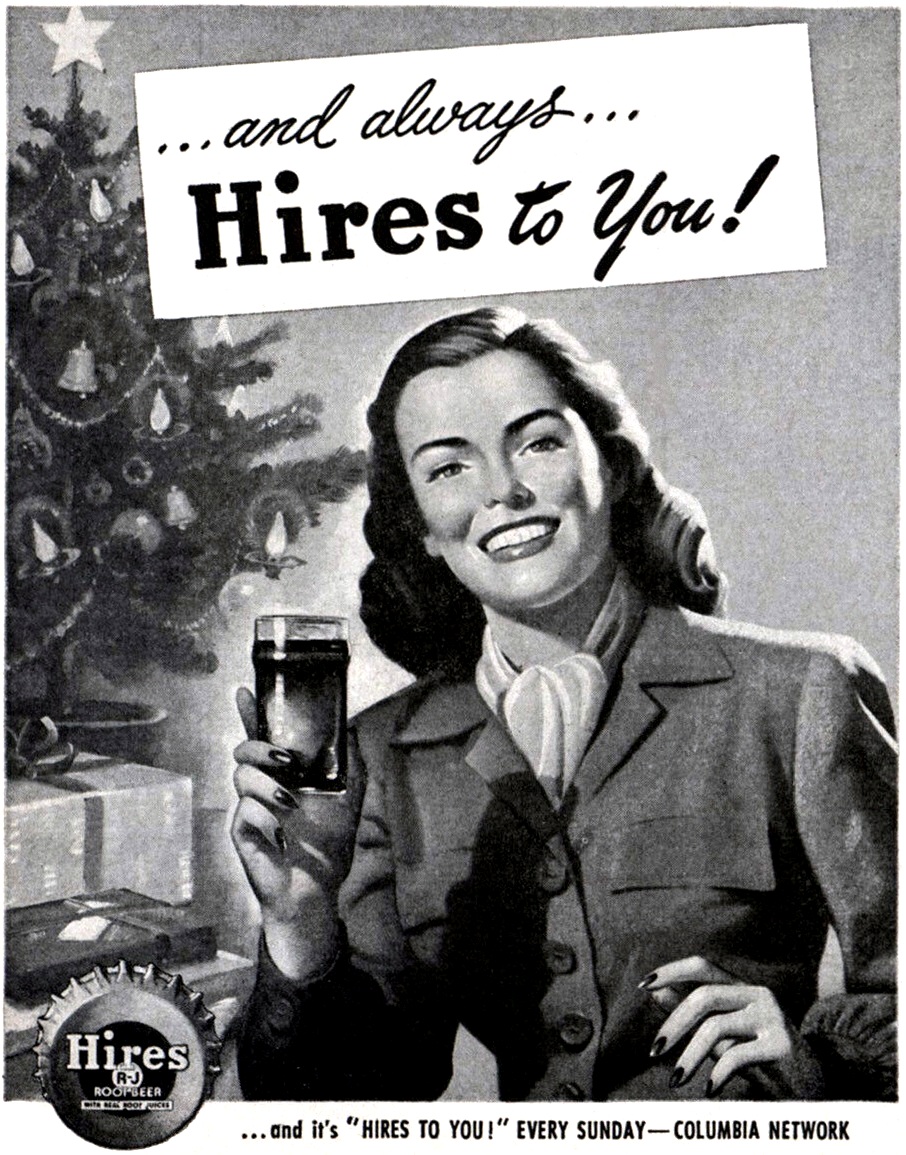1947
IT HAPPENED IN…1947
Americans faced rising prices for food, clothing,
and shelter, as manufacturers blamed industry-wide wage increases.
President Truman considered the housing shortage “the
foremost of the many problems facing the nation.”
The explosion of a nitrate-laden ship killed 500
people and obliterated Texas City, Texas.
Holt, Missouri was hit by a world record rainfall
when one foot of rain fell in 42 minutes.
A record-breaking 25.8” snowfall struck the
Northeastern U.S. December 27th.
38 magazines reported circulation of over one
million. In 1900, no
U.S. magazine had a circulation of over 5,000.
“You Bet Your Life” starring Groucho Marx
premiered on ABC Radio.
Buffalo Bob Smith and puppet Howdy Doody starred
on the first nationally broadcast children’s television show.
Cowboy movie and singing star Roy Rogers married
Dale Evans, cowgirl movie and singing star.
USAF Captain Chuck Yeager flew the Bell X-1
faster than the speed of sound for the first time.
The Brooklyn Dodgers signed Jackie Robinson, the
first black major league ball player.
He was named Rookie of the Year for 1947.
Many high schools began offering driver education
courses.
The Tucker automobile made its public debut in
Chicago.
Sugar rationing ended July 28, 1947.
The Nobel Peace Prize was won by the Quakers
(American Friends Service Committee).
Newly introduced products and inventions included
tubeless tires, microwave ovens, transistors, kitty litter, Ajax
detergent, Tonka Toys, Almond Joy candy bars, and Reddi-Whip.
Mason’s Root Beer was introduced.
Pennsylvania enacted a state tax on soft drinks
that was discontinued in 1951.
6,214 U.S. soft drink bottling plants were in
operation. Per capita
consumption was 150.9 bottles.
Early in 1947 Hires introduced the Volume 1, Number 1 issue of
Hires to You!, a periodic,
in-house magazine designed to enhance communication between management,
employees, and bottlers, while also hopefully stimulating sales.
The Philip Lyford front cover illustration featured a Hires team player
(note the “H” on his uniform) visiting with fans who were enjoying bottles of
Hires R-J Root Beer.
(Figure
1947-01, Hires
to You! Volume 1, Number 1, front cover)
Comments by Charles E. Hires, Jr., explained the purpose and goals for
Hires to You!
(Figure
1947-01, Hires
to You! Volume 1, Number 1, inside front cover)
E. K. Taylor, Crown Cork and Seal Company’s Machine
Division Sales Manager, was the guest author of this timely
Hires to You! Volume 1,
Number 1 article concerning bottling machinery:
WHY DELIVERY OF BOTTLING MACHINERY IS SLOW
A straightforward answer to the question bothering so many bottlers today.
"Why must I wait so long for my new machine?” is a
question that we are frequently called upon to answer.
It is a logical question and
one that we believe should have the most urgent attention.
Indeed, if there is any single problem facing the bottler today
that, more than any other, should be solved quickly it is the
replacement of worn-out equipment with new.
Certainly our own company is committed to that policy.
Never before in our history as an industry has
bottling machinery been subjected to so severe a test as during the
recent war years and after.
Long hours of almost uninterrupted operation without opportunity for
normal care and maintenance are all too vivid a memory to most bottlers.
Even now, many buyers of new equipment are obliged to remain on
the waiting list through no fault of their own.
With business booming in most sections and a greater-than-ever
need for new bottling machinery, it isn’t any wonder that the question
“Why?” comes up so continuously.
It would be a gratifying
experience, indeed, to be able to fill all of the orders on our books.
As a matter of fact, we would like to ship all of the machines
that are partially completed, awaiting the arrival of certain small but
vital parts like castings, tubings, motors, etc.
Since we cannot do that, let me tell you briefly what our own
company is doing about the situation.
Speed Up Repair Service
When we were forced to a realization of the fact that
our production schedules would be subject to such prolonged delays, we
revived the wartime idea of having bottlers return duplicate important
repairable parts to be repaired in our shops and put into a “pool” for
the benefit of other bottlers.
We also stepped up our repair-part service.
Naturally, the big objective was to keep bottling lines running.
Maintenance manuals, lubrication charts, and miscellaneous
reminder material on the importance of proper machine care were
circulated liberally.
Meanwhile, on our own production end, we established
a new and additional assembly plant with automotive-type assembly lines
to facilitate manufacture and take away some of the load from our
already over-burdened machinery plant, referred to above, upon
completion of which we would be able to step up all production schedules
to a maximum, consistent always with the availability of parts and
materials.
Within the last few weeks, we have moved all of the
production machinery from the old plant to the new.
Moreover, we have been able to acquire many new and faster
machine tools that we never had before.
The whole move was accomplished with such dispatch that we have
established something of a record, according to hauling experts.
All of us are enthusiastic about the possibilities, being
convinced that the greatest period of prosperity for the beverage
business is still ahead.
Nevertheless, the shortages are still with us even as
in the building trades, the automotive industry, paper, lumber, etc.
Most of these things are simply beyond our control.
What about the Future?
As to the future, this much can be said.
I am speaking now for our own company.
We are in a better position in every way to produce high-quality,
precision-standard bottling machinery than ever before.
We have the facilities and men with the know-how.
We are just completing an investment of several million dollars
to do a better and faster job of making bottling equipment.
Already production has increased.
And, as shortages are overcome, we will produced still more.
How long it will take to fill the orders now on our books, I
frankly do not know. But I
can say this. Things are
brighter now than they have been for a long, long time.
Another Hires
to You! Volume 1, Number 1 article provided insight into the
importance of quality controls as a critically important means for
protecting the company’s long-standing, stellar reputation.
THE MOST VALUABLE THING YOU OWN
When the fire swept away Cummings’ Drug Store, it
wiped out all of Joe Cummings’ physical assets.
He didn’t have a piece of merchandise to sell, not a cent of
insurance. But within a
year he was back in a new store, with new stock, doing more business
than ever. Cummings had one
thing that fire or flood or thunderbolt couldn’t destroy – a good
reputation. Even penniless,
in front of the smoldering ruins of his store, he was a man to trust.
People knew it, they liked to do business with him.
The banks knew it, they were glad to lend him money.
That’s the way with a reputation.
If it’s good, it’s the most valuable thing you own.
It takes years of effort to build it, one wrong act can destroy
it, and no bank in the land can lend you enough money to rebuild it.
Hires is no different from the small drug store, or
the doctor, or the tradesman in this respect.
The reputation of the product in the Hires bottle is to every one
of us the greatest asset.
Three Ways to Build Reputation
Hires’ reputation has been built in three ways:
First, the product has been
kept consistently excellent; in this respect, Hires has manufactured the
flavor from natural roots at a cost of many thousands of dollars over
its competitors.
Second, Hires has invested
thirty million dollars in advertising to attract consumer attention to
Hires flavor and purity.
Third, Hires has maintained
laboratory control.
Building a reputation is one
thing. Maintaining public
confidence in the product is another.
But it is of greatest importance that we do our part to protect
the reputation and warrant public confidence.
That’s why laboratory control is of such great consequence.
If we were bottling a product
made with artificial flavoring oils, every one of us could take a lot of
shortcuts. But we’re not,
and if we’re to enjoy full consumer-confidence, all of us must continue
to be worthy of it.
Expensive Protection Costs Less
That’s why the Hires laboratory employs a staff of
competent chemists and bacteriologists to constantly supervise all
phases of production. No
single bottler could maintain such a laboratory – but every Hires
bottler has this laboratory at his disposal at no cost.
In terms of dollars, perhaps,
the maintaining of the Hires laboratory is a great expense.
Actually it is an insurance, the
one way to insure the
continued excellence of Hires Root Beer.
There is no cheap way of doing this, for the least costly way –
the cutting of our staff or the less frequent testing of bottlers’
samples – would in the end prove the most expensive way of all.
It's Up to You
Hires laboratory control cannot do the whole job.
It’s up to you.
Responsibility rests with the people in the production department, where
one act of carelessness can cause spoilage, where getting another run
out of a tank of caustic can upset the sterility of many cases.
It’s up to the Hires bottler to send in his periodic samples for
laboratory testing.
Laboratory control is not only the consumer’s
protection. It’s your
protection. For not piece
of equipment, no plant, nor all of the physical assets of the company
are as valuable as the reputation of the product.
With that we are secure, and like all security, we must be
constantly at work to protect it.
These store display marketing suggestions included
input from both bottlers and company personnel (Houston Rogers was the
plant area manager in New Orleans, Louisiana).
(Figure
1947-01, Hires
to You! Volume 1, Number 1, page 13)
This article about cartons documents Hires’ historic
usage of cartons. A 3¢
carrier deposit boosted the total deposit for a six pack to 15¢, as
bottle deposits were 2¢ per bottle in 1947.
(Figure
1947-01, Hires
to You! Volume 1, Number 1, page 14)
The inside back cover details the Hires Company’s
operations and the people responsible for managing each area.
(Figure
1947-01, Hires
to You! Volume 1, Number 1, inside back cover)
A company-owned bottling and syrup plant in New
Orleans, Louisiana opened in February, 1947.
The Philip Lyford illustration chosen for the front
cover of Hires to You! Volume
1, Number 1 was re-used as a direct tie-in to launch of the spring
baseball season. Note the
tag line advertising the “Hires To You!” radio program on the Columbia
Network.
(Figure
1947-02,
Saturday Evening Post, April, 1947)
A delivery truck utilized by the Hires plant in Long
Island City, New York was featured in this advertisement for Specialty
Engineering Company’s “Zephyr Bodies.”
(Figure
1947-03,
American Carbonator and Bottler, April, 1947)
The company-owned bottling and syrup plant in
Milwaukee, Wisconsin opened in June, 1947.
Philip Lyford illustrated this magazine advertisement
that ran in the summer of 1947.
(Figure 1947-04, magazine
advertisement, 5.25” x 7.0”)
This Knox Glass Associates, Inc. full page
advertisement featured Hires R-J Root Beer bottles with Applied Color
Labels, marking Hires’ first use of ACLs.
Knox claimed their “strong, durable glass Knox Perma-Lettering is
the plus factor that gives products added sales appeal.
It can’t wear off, rub off – it’s permanent.”
(Figure
1947-05,
American Carbonator and Bottler, July and
September, 1947)
The Consolidated Decalcomania Corporation of Jamaica, New York, and Chicago, Illinois manufactured these 6.5" x 5.0" decals for Hires. They were applied inside on the glass in windows and doors, and also on the outside of mirrors, wood, or metal. The water soluble backing paper for the illustrated example has faded with age.
(Figure
1947-05.5, DuroAd "Double Duty" decal, front)
(Figure
1947-05.5, DuroAd "Double Duty" decal, back)
Hires to You!
Volume 1, Number 2 was distributed in mid-year 1947.
The cover image pictured Hires’ sugar plantation in Cuba,
featured in the “White Gold of the Caribbean” article on page 4.
(Figure
1947-06, Hires to You!
Volume 1, Number 2, front cover)
The inside front cover profiled Philip Lyford,
illustrator of numerous Hires advertisements, and Johanna Daly, the
model for Hires’ current Life
and Saturday Evening Post
advertisements.
(Figure
1947-06, Hires
to You! Volume 1, Number 2, inside front cover)
Cuban sugar was the featured “It Happened At Hires”
topic for Hires to You!
Volume 1, Number 2, page 4.
WHITE GOLD OF THE CARIBBEAN
Who has not dreamed of treasure?
Who has not thrilled to the story of iron-bound chests and pieces
of eight?
The lure of buried bullion has always gripped, and
probably always will, the imagination of men.
For long centuries the Spanish believed that
somewhere in the New World there was a land of El Dorado, a land of
fabulous wealth, with mountains of jewels and rivers of gold.
Treasure led the voyages of Columbus – the hope of a
short route to the riches of the East.
And when he came upon the Pearl of the Antilles set in a sapphire
sea, he thought he had opened the way to the Indies, and sent his
ambassadors ashore to call upon the Chinese Emperor he thought was
there. But his ambassadors
found, not Oriental potentates in palaces, but only Indians in
thatch-roofed huts, who called the island Cabanacan.
And the sea in which it gleamed was not the Indian
Ocean, but the storied Caribbean.
The Caribbean became the sea-center of this New
World, as the Mediterranean was of the Old.
To its waters came the discoverers, the conquistadores, pioneers
and pirates – all led by the lure of gold that was the inspiration of
every voyage and the dream of every adventurer who clamored into the New
World.
Always the search for El Dorado went on, carrying men
further and further inland.
But some stayed behind and built settlements by the sea, to make their
wealth out of the products of the land, out of sugar and tobacco.
Tobacco Columbus found native in Cuba, but sugar was
introduced by the Spaniards and since early days has been the dominant
crop of the island. The
Spaniards set up huge plantations and ran them with slaves – natives,
Africans, and white men sent out from the criminal courts of Europe to
serve their sentences under the whiplash of the plantation overseer.
The wealth of the Spanish Main, in the commerce
between the Old World and the New, attracted those gentlemen of high
adventure, the buccaneers who swarmed in these tropical waters to
plunder, in turn, the ships and the ports.
Perhaps the most colorful pages in the history of the
Caribbean are those devoted to tales of the buccaneers – from Giovanni
da Verrazono, the first pirate, through Hawkins, Drake, Morgan, and
others, down to Jean LaFitte, last of them all the idol of gay New
Orleans.
Cuba has been called the island of a hundred harbors,
for its coast is ragged with inlets and bays, ideal hiding places
between raids for the ships and crews that sailed with the Jolly Roger.
Its cities, rich in their plantations, were periodically sacked,
and the unhappy residents led a life harassed by these marauders from
the sea.
The grim citadel of Morro Castle was built to protect
the capital city from the pirates in those early days, and from 1597 to
this day Morro Castle has stood guard at the bottleneck entrance to the
harbor of Havana.
The pirates have passed away, with the pages of time.
But the plantations live on.
Today these peaceful ports, where buccaneers once stomped with
their flagons of rum, turn out one of the basic ingredients for soft
drinks (that should lay the ghost, once and for all, of any buccaneer
still roaming around!). The
wealth of the island is not pieces of gold, but crystals of sugar.
And among the plantations that cover the eastern
coast of the island with a sea of grass is Central Dos Rosas, the
plantation of the Charles E. Hires Company, which makes some thirty
million pounds of sugar annually.
During World War I when the
sugar situation became very severe (as it did during World War II),
Hires went down to Porto Rico and contracted for one-half the output of
a sugar mill there – something
that had never been done before in the beverage business.
But then the U.S. Government took over the shipping
and production of sugar.
Hires received the permission of the Government, however, to charter
wooden schooners and bring the sugar to the United States, in return for
which the Government permitted Hires to retain one-half the sugar so
brought the result being that during the first war period Hires was
able to meet its sugar requirements.
Out of this incident came the purchase of Central Dos
Rosas in 1919. Since that
time Dos Rosas has made over 600 million pounds of sugar for Hires.
It has been one of the very few plantations in Cuba that has not
changed hands, plunged into bankruptcy, or gone out of business in the
past 28 years.
Cane is still harvested by machete and loaded by hand
into carts pulled by oxen.
Fields yield for an average of five to seven years before replanting,
but may produce for as long as fifteen or twenty years.
There are such great areas of sugar fields on the plantation that
a small railroad of some fifteen miles is necessary to bring the cane
into the mill. The daily
cane haul at Dos Rosas is about 2.5 million pounds.
Such is the colorful background of Cuba and the Hires
plantation. The rivers of
gold have indeed become streams of sugar.
The photo accompanying this article pictures Joseph
W. Riley, Hires’ Manager National Accounts, obtaining a cup of Hires R-J
Root Beer from a Hires vending machine.
(Figure
1947-06, Hires
to You! Volume 1, Number 2, page 6)
A three page
Hires to You! Volume 1, Number 2 article by Edward Stern, Hires
Personnel Manager, provided detailed insight into the company’s approach
to personnel policies:
HIRES AND YOU
The success of any business organization depends
primarily on the ability, effectiveness, and spirit of the people
associated with the company – from the fellow who sweeps the floor in
the plant to the president and directors who manage the business.
Competing companies have about equal access to money,
machinery, and materials.
It is the company with the best men (and product), the most efficient
and satisfied employees, that forges to the front.
Modern industry has brought into existence large
manufacturing units of hundreds, even thousands, of men and women.
With this development has come an increasingly great problem in
personnel relations – in contrast to the small unit where the owner of
the company knew every employee and every employee knew him.
All industry today has made considerable strides in
the development of personnel programs.
Even so, we have much to learn about men and groups of men and
how best to get along in the modern industrial relationships so as to
achieve overall efficiency and satisfaction.
To assist in accomplishing this end, leaders in
industry today are devoting more and more attention to the accurate and
carefully organized personnel program as one of the fundamental
necessities for a successful business operation.
The basic theme of the Charles E. Hires Company’s
personnel policy may be found in a frequently used statement: “We want
our company to be one with which you may be proud to be associated.”
The Hires Company’s leadership in the field of
management-employee cooperation stems from a conscientious and constant
effort to carry out this idea in actual practice.
The program of the Hires Company for developing this
idea is outlined in the following points: the Company shall seek:
1. To place the most capable person available in each position;
2. To train these selected persons thoroughly so that each may become more successful in his job;
3. To provide for job and income security for each employee;
4. To pay each employee a fair wage for the work performed;
5. To afford a safe and orderly working place for each employee;
6. To give each employee an opportunity to be prepared in case of sickness, accident, disability, or death -- and an income for his declining years;
7. To instill in each employee price in the products, policiies, and progress of the organization and his opportunities;
8. To inform the employees of what the company is doing, its plans and progress, and give opportunity to all to express their opinions and suggestions.
The establishment of the
personnel department in the Hires Company, the extent to which effort,
time, and financial support is accorded it, is a job for
top management.
The job of making the established program live is the
responsibility of all levels of
supervision.
There are five central areas with which the Hires
management is especially concerned in discharging its responsibilities
in personnel relations.
These are personnel planning and research, employment, training,
personnel records of achievement, and employee services and security.
Just as a company must plan its future insofar as
finances, equipment, distribution, policies, etc., are concerned, so it
must plan the future for its organization as well.
Capable employees don’t just happen.
They must be sought, be secured, be properly placed and
developed. To assure the
success of any company, great care must be exercised in the original
selection and placement of individuals.
The Hires Company is outstanding in industry today in its
personnel relationships because of its policy of employee selection,
placement, and development.
Training in the Hires Company begins with the hiring
of the new employee. The
objective of the Hires plan is to develop the individual to the point of
greatest effectiveness to himself and to the company.
Obviously, then, it is a continuing action without end.
The new employee is instructed in the history, the policies and
program of the company, something of the character of his supervisors
and managers, as well as what will be expected of him.
His induction includes not only training in the skill of the job
he is given, but an understanding of the company, the department, and
the relationship of his job to the operations that have taken place
before and those taking place after.
He is further advised of the importance of his personal
contribution to the whole program.
In the Hires Company with its
policy of “promotion from within,” this plan of continuous training and
development of employees has “paid.”
Most of the important jobs within the company have been filled by
promotion of employees from the ranks.
Before filling any important job, the Hires Company carefully
evaluates all employees who may be possible candidates for the job.
Closely related to this policy is the necessity for
knowing what each individual is expected to do on his particular job,
how well he is doing these things, and his potential for future
advancement. To this end,
therefore, the company maintains accurate and complete knowledge of
employees’ performances and capacities.
In other words, the requirements of the organization through
planning and also the needs of the individual through an effective
personnel record must be known in selecting and training those slated
for advancement.
The opportunities for cementing friendships, building confidence and understanding by personal contact through such an active personnel program are self-evident in the Hires Company.
It is interesting to note that all employees who
served in the armed forces during the war – over 200 – returned to the
employ of the Company upon discharge, with the exception of one man who
went into business for himself.
A “What Do You Think?” page provided an
opportunity for Hires employees to provide marketing suggestions.
This issue’s topic was how best to increase sales during “the
so-called slack period of the Fall and Winter months,” a major marketing
challenge for many bottlers, particularly those in cold winter weather
areas.
(Figure
1947-06, Hires
to You! Volume 1, Number 2, page 13)
Floor displays in stores were “without doubt the
single most effective means of moving merchandise…it puts bottles within
reach of the consumer. It
sells.” The pictured
display at a market included a pyramid of Hires six-pack cartons, with a
die-cut, cardboard Hires sign on top.
(Figure
1947-06, Hires
to You! Volume 1, Number 2, page 14)
The
“In The Spotlight” page profiled Joseph Perkins, Chief of Hires’
Laboratory Department, a Hires employee since 1908.
(Figure
1947-06, Hires
to You! Volume 1, Number 2, inside back cover)
Here is the
Life and Saturday Evening
Post advertisement featured in the profile on artist Philip Lyford
and model Johanna Daly in Hires
to You! Volume 1, Number 2.
(Figure 1947-07,
Life
and Saturday
Evening Post)
Johanna Daly was the model for these three advertisements illustrated by
Philip Lyford.
(Figure 1947-08, magazine
advertisement)
(Figure 1947-09, magazine
advertisement)
(Figure 1947-10, Saturday
Evening Post)
A black-and-white version of this Philip Lyford
illustration of three couples at a party was used for a magazine
advertisement, while a full-color version was used for this sign.
(Figure 1947-11, cardboard,
easel-back, counter display sign, 12.0” x 16.0”)
A
portion of the same Philip Lyford illustration was reused as cover art
for "Hires to You!" sheet music.
The song was written by Phil Davis, orchestra leader for the
Sunday broadcasts of the Hires Radio Show on CBS.
(Figure 1947-12, “Hires to
You!” sheet music, four pages)
A portion of the Philip Lyford artwork was also used
for this bottle topper.
(Figure 1947-13, die-cut,
cardboard, bottle topper, 11.0” tall)
(Figure 1947-14, porcelain
door pusher, 4.0” x 6.0”)
The Hires R-J ROOT BEER lettering on this tin sign is embossed. The outside border shows traces of rust due to weathering.
(Figure 1947-14.5, tin sign,
12.0” x 24.0”)
The R-J and WITH REAL ROOT JUICES lettering on this
similarly designed sign is blue instead of white, and the designer
failed to underline the R and J in ROOT JUICES.
(Figure 1947-15, porcelain
sign, 6.5” x 10.5”)
(Figure 1947-16, self-framed,
tin sign, 11.0” x 35.0”)
(Figure 1947-17, embossed, tin
sign, 13.5” x 19.0”)
A Canadian version of the same sign was manufactured for use in Quebec and printed in French. "Buvez Un Choix de Bon Gout" translates to "Drink a Tasteful Choice." The bottom edge is marked "P-567 S.T.S.P."
(Figure 1947-17.5, embossed, tin
sign, 19.0” x 26.75”)
(Figure 1947-17.8, paper
sign, 13.5” x 5.0”)
This pressed tin license plate topper measures 6.25" x 6.0":
(Figure 1947-18, pressed tin
license plate topper, front)
(Figure 1947-18, pressed tin
license plate topper, back)
(Figure 1947-19, cardboard
sign, 13.5” x 16.5”)
This novelty bottle has ACL labels. The front reads "DOES NOT CONTAIN ROOT BEER," while the back reads “This is a Novelty – DO NOT DRINK – Not a Beverage – This bottle contains colored water – Bottled by Bill’s Specialty Mfg. Co. – Milwaukee, WIS. These bottles were also produced as salt and pepper shakers, with holes drilled in the crown cap.
(Figure 1947-20, clear glass
novelty bottle, front and back, 3.5” tall)
The ACL label on the front of this miniature bottle also reads "DOES NOT CONTAIN ROOT BEER," but the back is blank. The base is embossed "MUTH PAT. PEND BUFFALO indicating the bottle was produced by Edward Muth & Sons of Buffalo, New York, a major manufacturer of promotional salt and pepper shakers.
(Figure 1947-20.5, amber glass
novelty bottle, front, 2.5” tall)
(Figure 1947-20.5, amber glass
novelty bottle, base)
The front of this wooden, six-pack carrier bears the
upper portion of a Hires R-J ROOT BEER logo, while one end panel has a
Hires R-J ROOT BEER WITH REAL ROOT JUICES logo.
The back panel is marked “Drink CANADA DRY Spur AMERICA’S
FAVORITE FLAVOR” and the remaining end panel bears a Canada Dry crown
logo reading “Drink CANADA DRY Spur” (Spur was trademarked November 20,
1944). The center divider
is marked “The new consumer case TRADE MARK.”
(Figure 1947-21, wooden,
six-pack carrier, front)
(Figure 1947-21, wooden,
six-pack carrier, back)
Here's another illustration penned by Philip Lyford.
(Figure 1947-21.5, Life,
September 15, 1947)
The copy in this advertisement describes Hires R-J
Root Beer as “a supremely fine beverage that has led its field for 77
years,” attempting to date Hires' founding to 1870.
(Figure
1947-22,
American Carbonator and Bottler, September 1947)
The September, 1947
American Carbonator and Bottler
advertisement also mentioned the opening of “greater production and
enlarged distribution facilities permit us to allot new franchises.”
New September, 1947 openings included a company owned bottling
and syrup plant in Newark, New Jersey, and a company-owned bottling
plant in Burbank, California.
This advertisement continued Hires’ drive to identify new
franchises.
(Figure
1947-23,
American Carbonator and Bottler, October 1947)
Although Hires was a national bestseller, the brand
was weak in the Seattle market.
Steve Sourapas' father, James Sourapas, had a fine rapport with
the Hires district manager and obtained an exclusive franchise licensing
“Hires Bottling Company – Seattle, Washington” effective October 15,
1947. Charles E. Hires Jr.
signed this letter welcoming James (back) to the Hires “family” as if he
hadn’t heard of him before and wasn’t aware Hires had cancelled his
franchise 15 years earlier.
(Figure 1947-24, new licensee
appointment letter, October 15, 1947)
(Figure 1947-25, new licensee
agreement, Hires Bottling Company, Seattle, Washington)
The fine print in the licensee agreement specified:
(2) The Licensee will carbonate Hires only in standard Hires 12 oz. and 26 oz. bottles with standard Hires labels and crowns in accordance with this License and sell the same within and throughout the territory covered by this Agreement, but not elsewhere without the written consent of the Company, and WILL FULLY AND ADEQUATELY SUPPLY THE PUBLIC DEMAND THROUGHOUT SAID TERRITORY, as evidenced by route books which the Licensee agrees to compile and keep up to date, showing daily deliveries made from his own trucks; the Licensee will also endeavor to have route books maintained by any independent distributor whom he may appoint to cover territories not serviced by his own trucks.
(3) The Licensee further agrees that he will neither
advertise, sell, bottle nor distribute, during the term of this
Agreement, any other brand of Root Beer, or any product whose flavoring
base is similar to that of Hires, it being understood that the Company
shall be the sole judge in this respect.
The Licensee further agrees that, during the term of this
Agreement, he will not, except with the written consent of the Company,
advertise, sell, bottle or distribute any product other than those
products so advertised, sold, bottled or distributed at the time of the
signing of this Agreement.
In
addition to a blue ACL Hires logo, this glass bears ounce, tablespoon,
pint, and cup measurement markings.
(Figure
1947-26, clear glass with blue ACL, 4.75” tall, 2.5” diameter)
(Figure
1947-27, Hires
to You! Volume 1, Number 3, front cover)
The inside front cover of
Hires to You! Volume 1,
Number 3 depicts the college football-related advertisement placed in
Life and
Saturday Evening Post in
November, 1947. Alice Tyne,
the artist, and Sally Sue Stephenson, the model, were profiled.
The reference to Alice as “one of the Powers Girls” relates to
her association with the John Robert Powers modeling agency in New York
City.
(Figure
1947-27, Hires
to You! Volume 1, Number 3, inside front cover)
This Hires to You! issue’s “It Happened at Hires” feature outlined Hires’ switch to company-owned fleet delivery vehicles that started in 1936 (see the 1936 chapter for the first portion of this article):
IT HAPPENED AT HIRES
(Figure
1947-27, Hires
to You! Volume 1, Number 3, page 4)
This year, 1947, completed the list of changeovers when Minneapolis swung in line with the rest of the Hires plants. Since then the new Burbank, New Orleans, and Milwaukee company plants have started up, each maintaining its own fleet, and other new plants are to follow shortly.
This has meant a great deal of
added expense in trucks, driver salesmen, loaders, night shifts,
maintenance and housing of the trucks, revised and enlarged loading and
unloading facilities, as well as the installation of an entire new sales
organization. These
operations, plus others not enumerated here, have constituted a
tremendous job. Even now,
in 1947, we are still engaged in finishing up this work.
Do the results warrant the cost?
We think so. All
plants, within a year after having been reorganized into operating their
own fleets, have shown great gains in distribution.
These gains vary from 20% to as high as 64% depending, of course,
on what kind of job the former individual distributor did in his given
area.”
Another feature article discussed the rise of radio
advertising and the “Hires To You” program:
THE URGE TO LISTEN
One of the most powerful influences in America’s
economic life, as well as its education, has developed full blown during
only the last two and one-half decades.
That influence is radio – reaching today through more
than 60 million sets (the entire population of the United States is 140
million) into homes and gathering places through all the country –
village, town, city and huge metropolitan areas alike.
It is a powerful influence for
good! It is an influence
that not only adds to the enjoyment of life through entertainment – but
also informs, educates, and contributes to the highest standard of
living ever achieved in the history of the world.
It is as well a powerful
salesman, and that is why Hires uses radio.
Forget, for a minute, the hugeness of radio – the 60 million
sets, the more than 1500 broadcasting stations, the tens of millions of
dollars invested each year by advertisers.
Let’s think in terms of our own home, our own community, our own
sales district. Do you now
that, based on national statistics, the people surrounding you own more
radios than bathtubs, automobiles, or even telephones?
Do you know that these people prefer radio to movies, reading or
sporting events?
Through one of the most outstanding radio programs in
America, the Hires message – your message – is being heard Sunday after
Sunday, month after month by the people in your community.
The purpose, of course, is to help you increase your sales in
your district – and thereby to maintain and expand that great group of
people in all parts of this country and, indeed, the world who receive
all of part of their livelihood as a result of those OTHER people who
ask for Hires.
Statistics show that 5,000,000 listeners each week
(or 260,000,000 listeners a year) hear “Hires To You” every Sunday
afternoon. Sales of other
products have shown amazing growth as a result of radio.
It is one reason for the 57% increase of Hires carbonated sales
since the end of sugar rationing in face of strong beverage competition
in all sections of the country.
Seek the program wherever you go.
Listen in to “Hires To You” each week.
And think to yourself how many tens of thousands or more people
in your community are receiving the Hires message.
How many “Hya’s” or “Here’s To You” have become “Hires To You?”
This Hires to
You! issue also profiled another important ingredient of Hires Root
Beer, vanilla…
MAKE MINE VANILLA
Orchids to Vanilla...the chocolate-covered bean
Did you know that vanilla – just plain vanilla –
belongs to the orchid family?
Yes, this familiar flavoring agent is really not, botanically
speaking, a bean at all, but a flower – the dried pods of a
reddish-brown and white orchid.
And also strange as it may seem, the best varieties
of cured vanilla beans are a very dark brown chocolate color!
To add to its oddity, vanilla has even been described
as a restorer of lost youth, according to the writings of a Franciscan
priest way back in the 16th Century.
In those days when Cortez conquered Montezuma, he
found the Aztecs using the vanilla bean as a flavor – and also a perfume
– and he carried the custom back to his native Spain.
You too enjoy the same kind of vanilla bean that the
ancient Aztecs used, for the fragrant vanilla that constitutes one of
the ingredients of Hires also comes from the lands south of the border –
and the islands of the Pacific.
Some years ago, the founder of the Company, Charles
E. Hires Sr., made a trip to Papantla in the heart of the
vanilla-growing district of Vera Cruz, in Mexico, because he wanted to
familiarize himself firsthand with the growth and preparation of this
aromatic ingredient. Here
he saw the vanilla vine growing thickly in a tropical forest just as it
had centuries ago when Montezuma ruled the land.
Plump and long-stemmed, the plant attaches itself to
trees and climbs by means of aerial roots, but, contrary to some
opinion, it is not a parasite and has its own roots in the ground.
Draping itself from tree to tree, it forms waving
green arbors and festoons in the forest, so dense, Hires noted, that
sometimes the sun cannot penetrate the leaves at high noon.
And cultivation consists mainly in cutting away the forest to
give it room to grow.
The fruit of the plant, after the flowers fall, is a
pod that grows in bunches resembling long thin bananas.
When mature, the clusters are cut and taken in sacks to the
curing station.
Now comes the most important part.
It is the process of
curing that develops the flavor we enjoy so much.
This is a matter of correctly sunning, sweating and drying the
beans over a period of several months.
Great skill and experience are required in the process so as to
bring out all the delicacy of the flavor and the rich chocolate color.
This skill reaches a high point in Mexico where the
man who is an expert in this line is regarded as a kind of super chef.
Mastery of the curing art requires precise timing to avoid
burning the beans – the kind of timing demanded in good cooking.
Too many minutes can spoil the crop!
Under the bright blue Mexican sky, the green beans
are placed in rows on straw mats at the curing station and exposed to
the blazing sun for about an hour.
Warm from the sun, they are next placed in blanket-lined boxes,
covered with more blankets, and sweated for 24 to 48 hours.
Afterwards they are placed on drying racks in a warehouse with
good ventilation, where they cool for several days.
The whole procedure is repeated several times until
the pods are mere shadows of their former selves.
Five pounds of beans shrink to one pound.
But in the process is formed that smooth brown bean – and that
orchidaceous flavor is present in Hires that Americans love so much.
As a matter of fact, the Hires Company is one of the largest
industrial users of the vanilla bean in the United States today.
This issue’s “What Do You Think?” topic was
“probably the worst nightmare confronting the bottling industry today,”
soft drink taxes. This
discussion was driven by passage of a state tax in Pennsylvania in 1947.
The responses were provided by Hires employees and an Ohio Hires
bottler.
(Figure
1947-27, Hires
to You! Volume 1, Number 3, page 13)
The “In The Spotlight” profile inside the back cover
focused on “Ephraim Wilson – Hires’ Oldest Employee – from 1889 - 58
years of service. Born
October 13, 1861.”
Amazingly, Eph Wilson was born during the Civil War and still working at
Hires in 1947!
(Figure
1947-27, Hires
to You! Volume 1, Number 3, inside back cover)
Here's the college football-related advertisement that was featured inside the front cover of Hires to You! Volume 1, Number 3.
(Figure
1947-27.5, Life and Saturday Evening Post, November,
1947)
This electric wall clock measures 30.0" wide, 17.0" tall, and 6.5" deep. It is backlit by two fluorescent light bulbs.
(Figure 1947-28, hard plastic,
electric wall clock)
(Figure 1947-29, magazine
advertisement)
SHORTAGES STILL PLAGUED THE SOFT DRINK INDUSTRY AS
1947 ENDED
Sugar continued to be in short supply, further
impacted by the shipping of large quantities to Europe as part of
post-World War II relief programs.
The severe shortage of soda ash for manufacturing new bottles
during the war lessened and new bottles became available again, but at
higher prices. The
combination of rising sugar and bottle prices further squeezed profit
margins for soft drink bottlers who continued to charge only 5¢ for
their product. Federal
price controls on sugar ended October 31, 1947 with passage of the Sugar
Control Act of 1947 and the soft drink industry recovery finally began
in earnest.


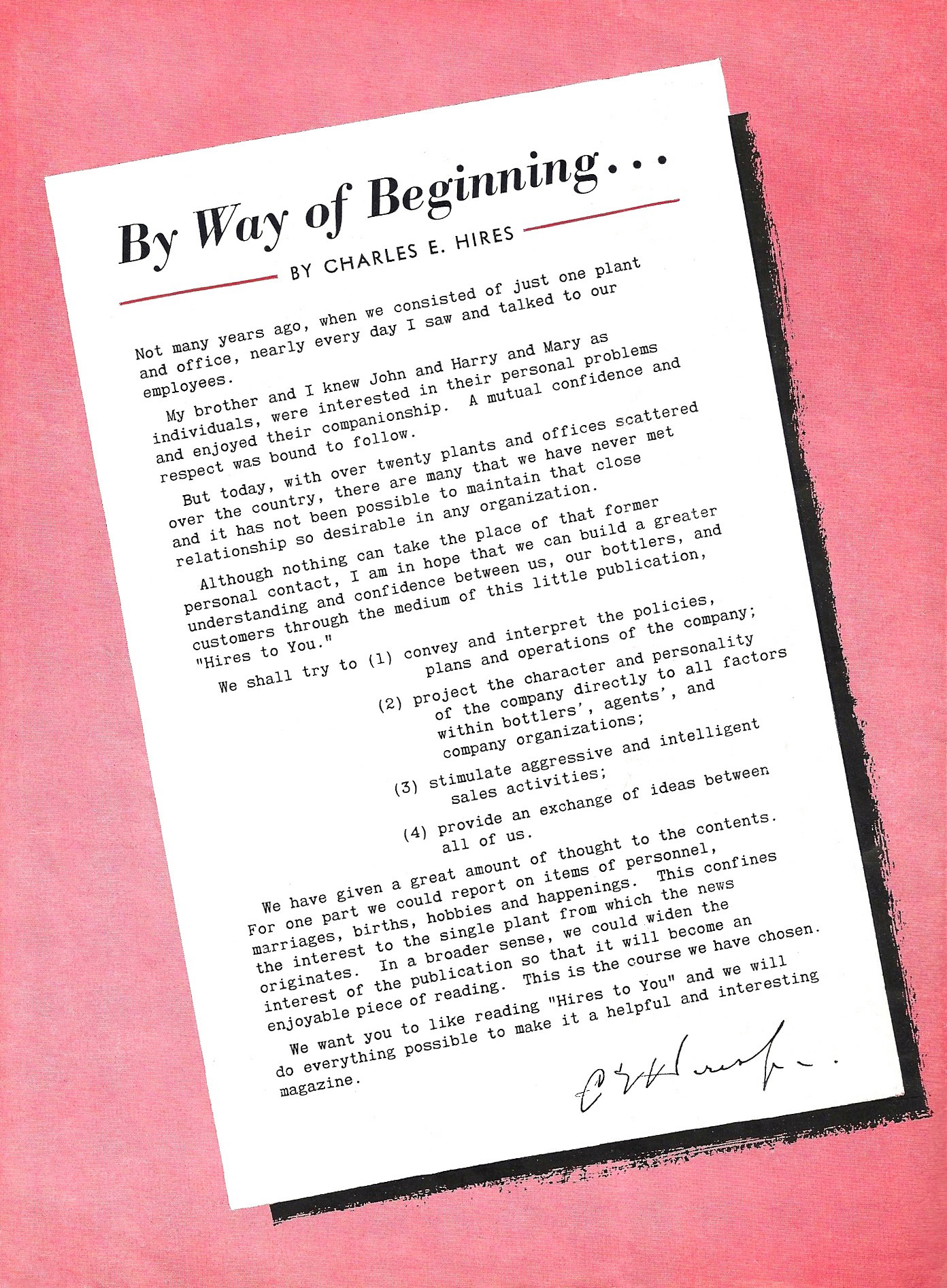
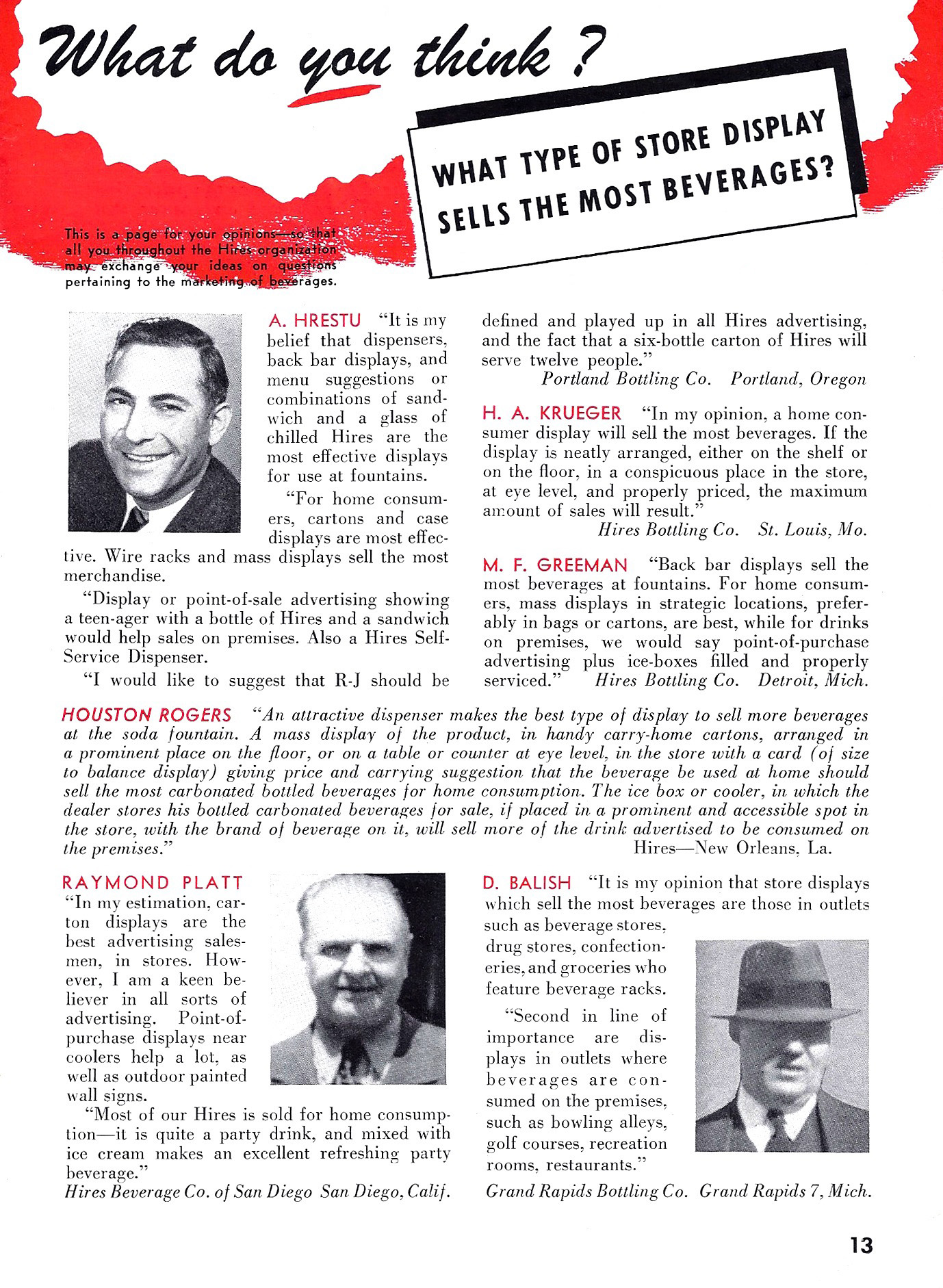
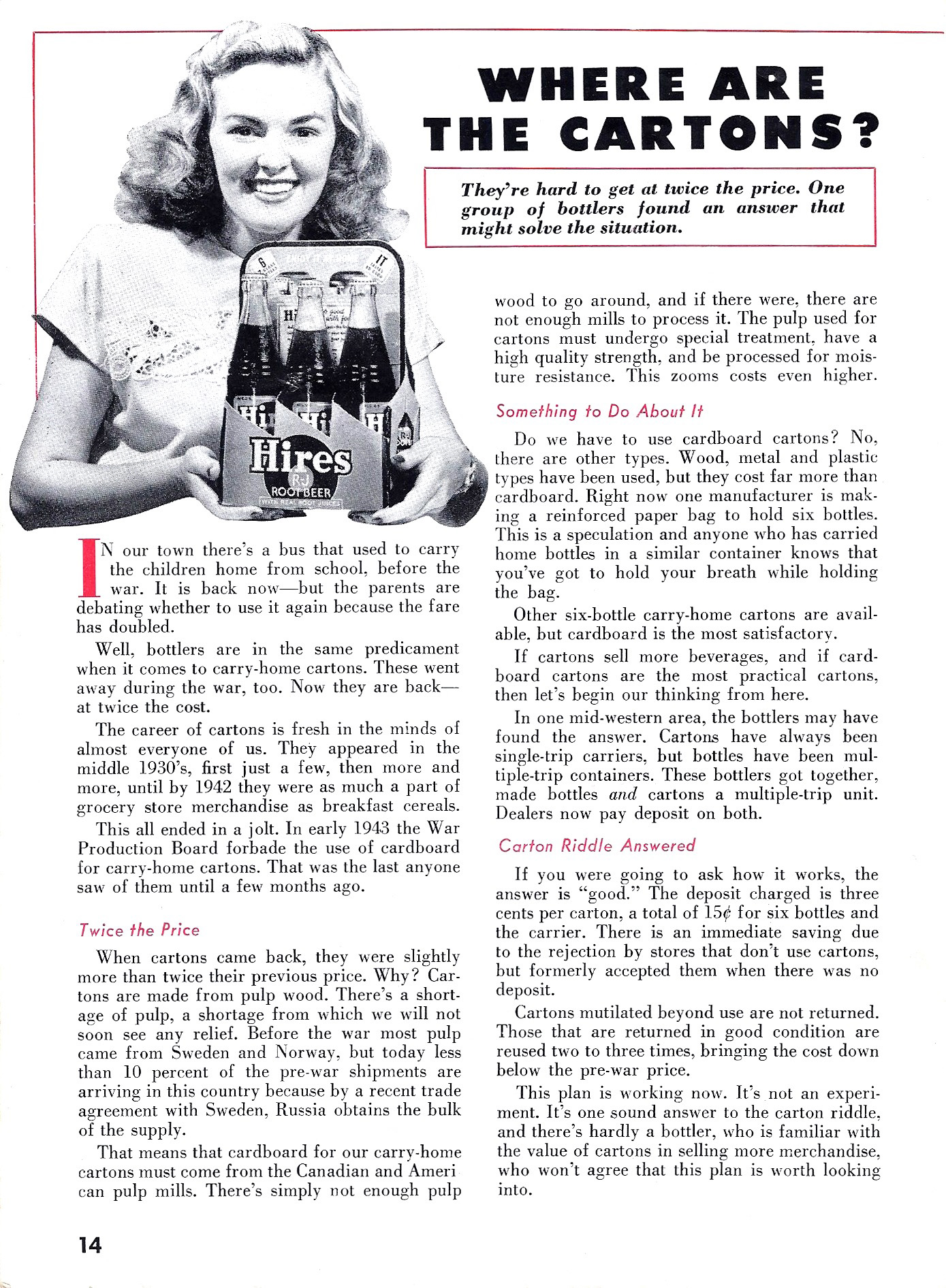
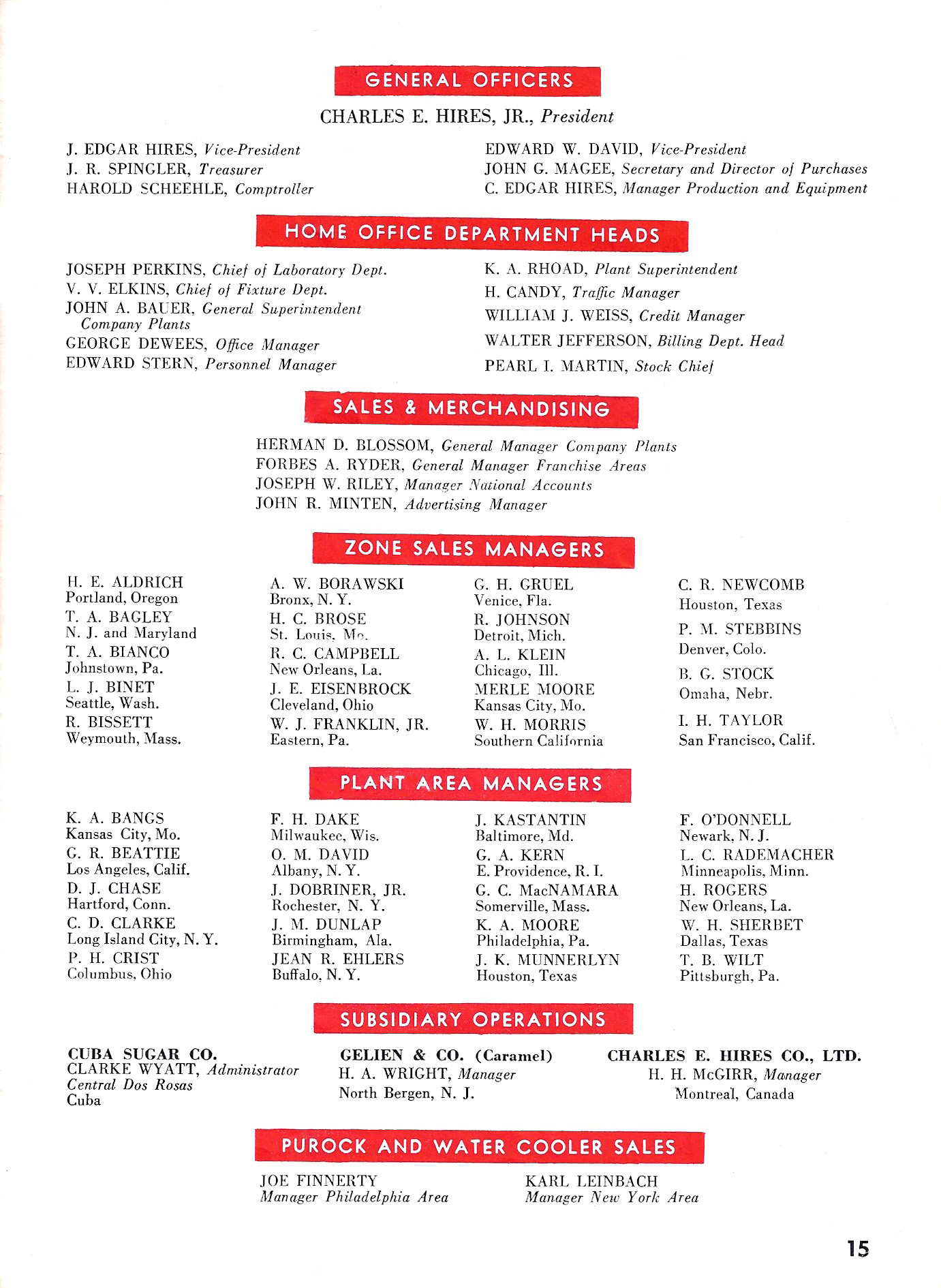
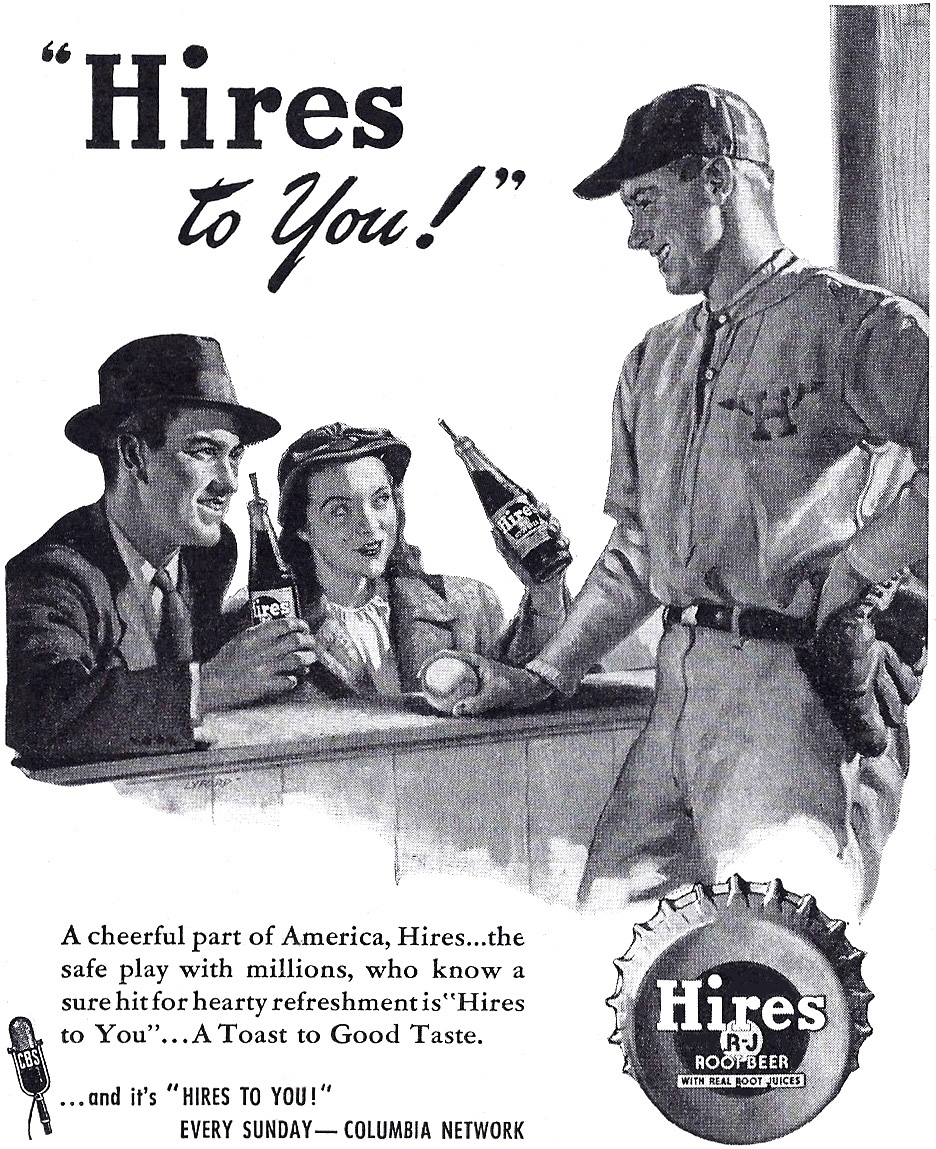


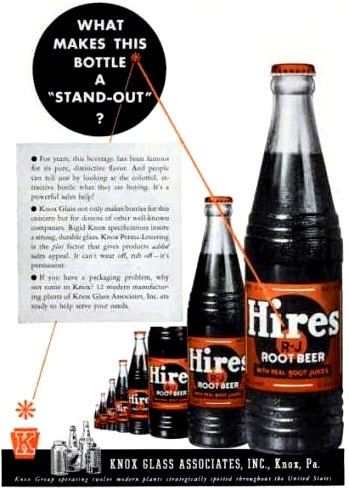
%20Root%20Beer%20With%20Real%20Root%20Juices%20-%20DuroAd%20decal%20-%20front.jpg)
%20Root%20Beer%20With%20Real%20Root%20Juices%20-%20DuroAd%20decal%20-%20back.jpg)
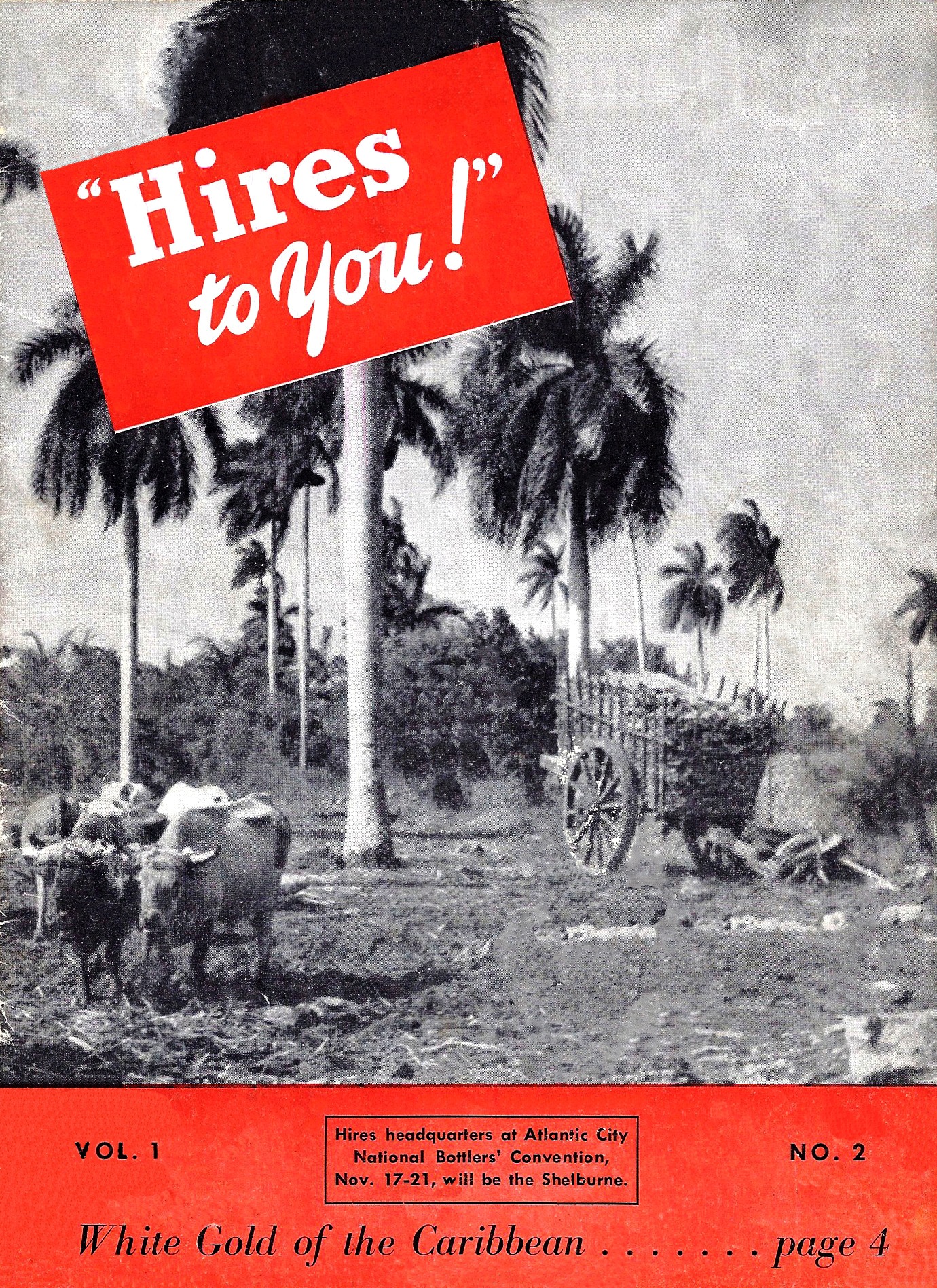

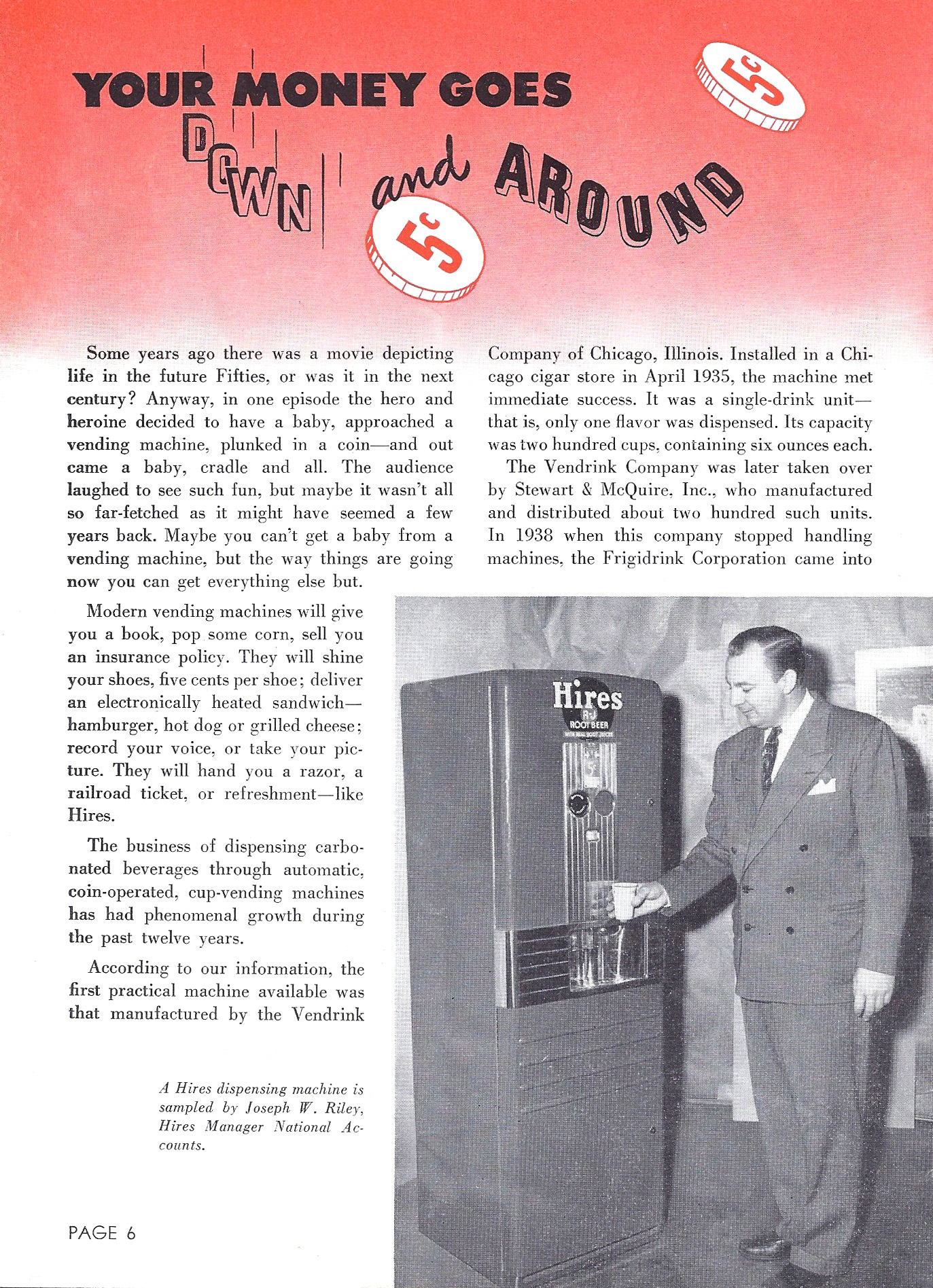
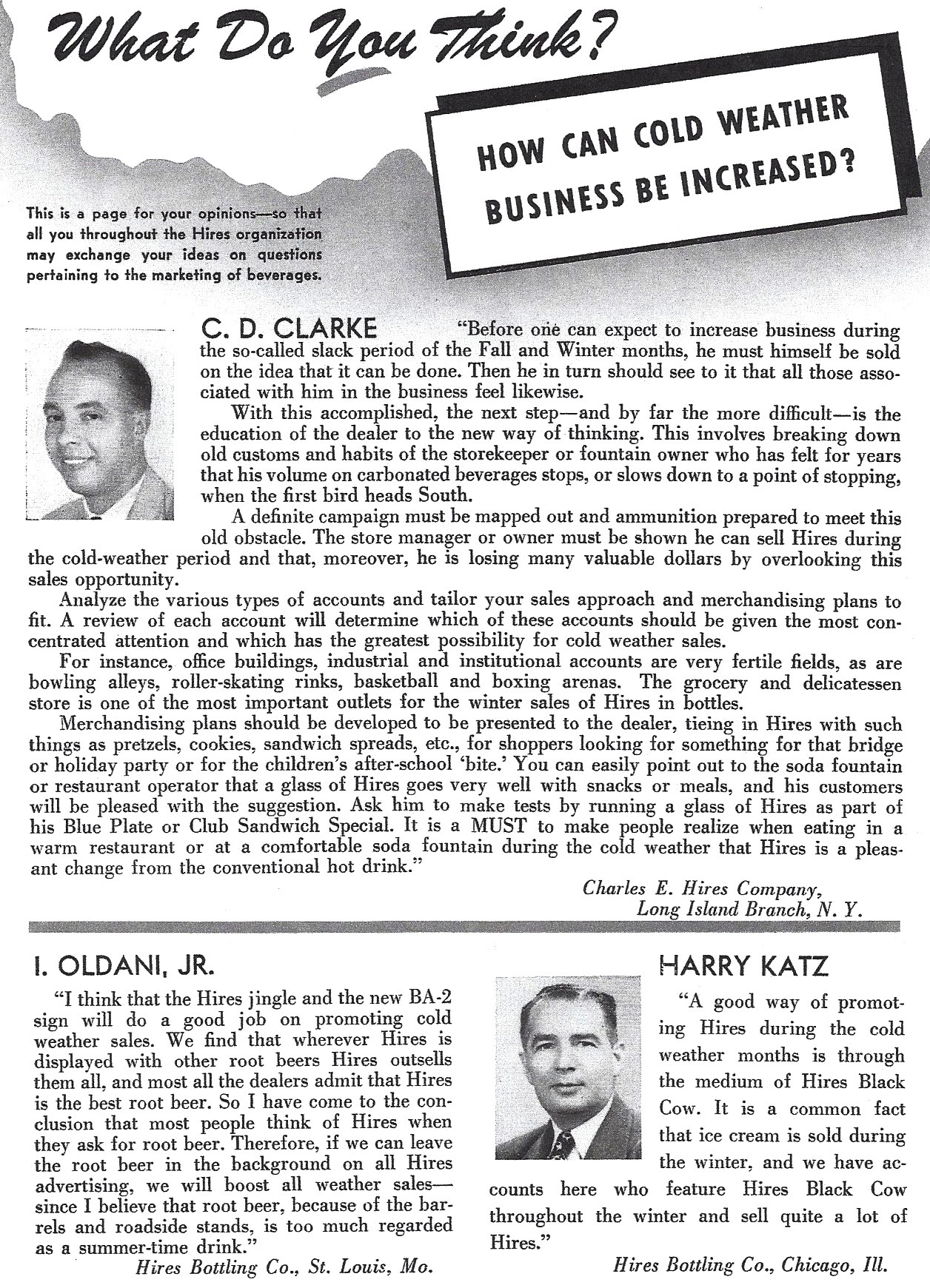
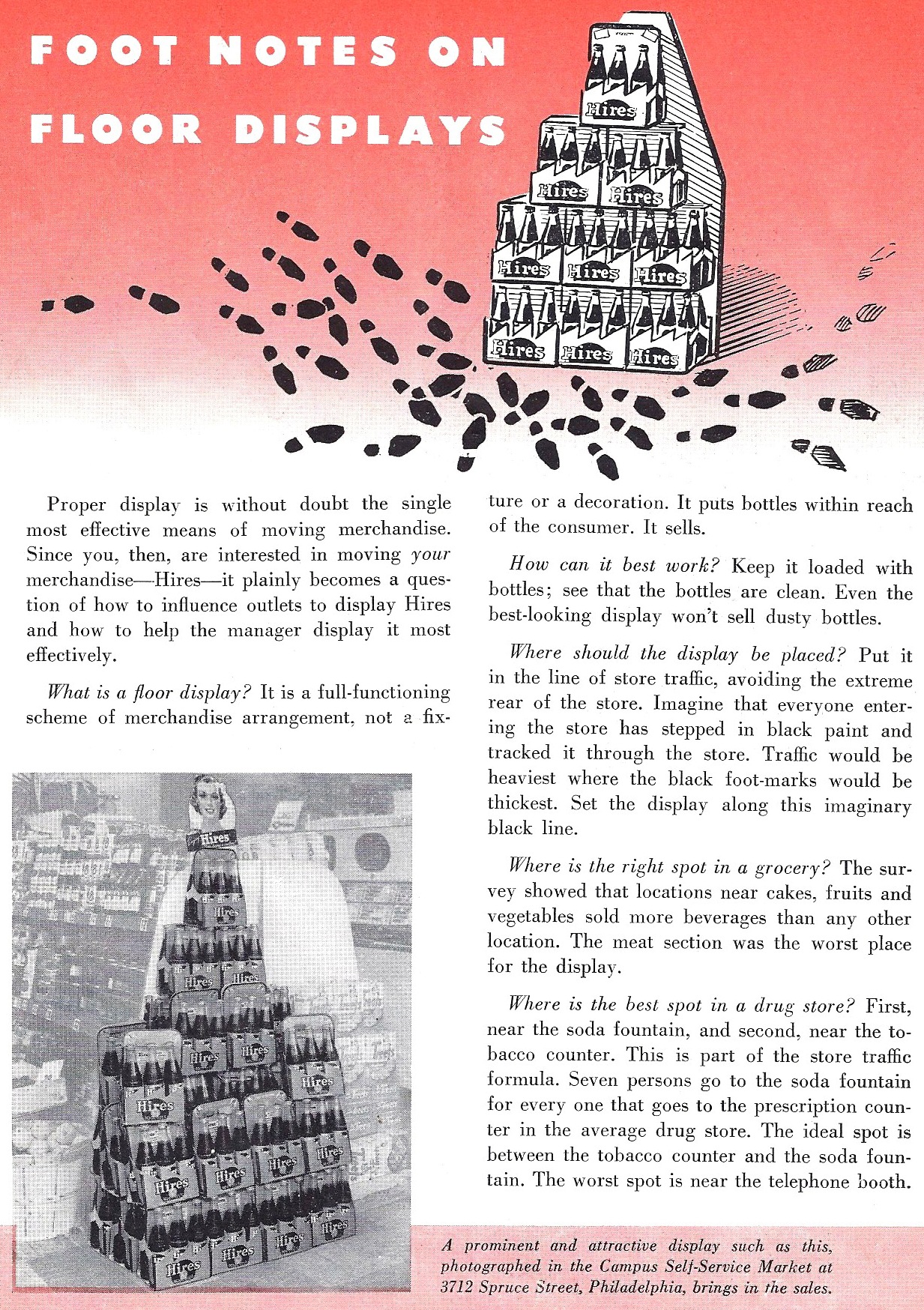
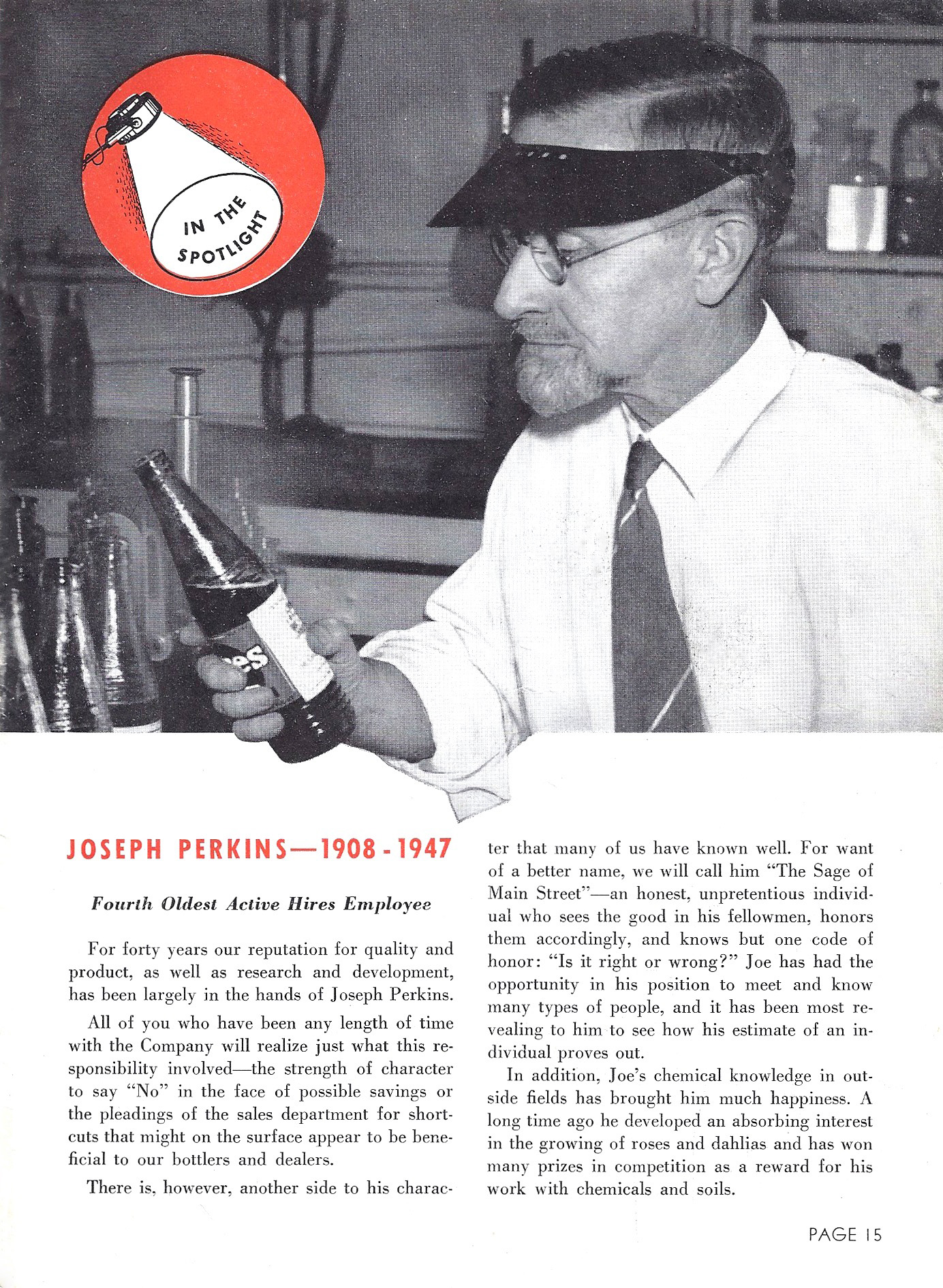
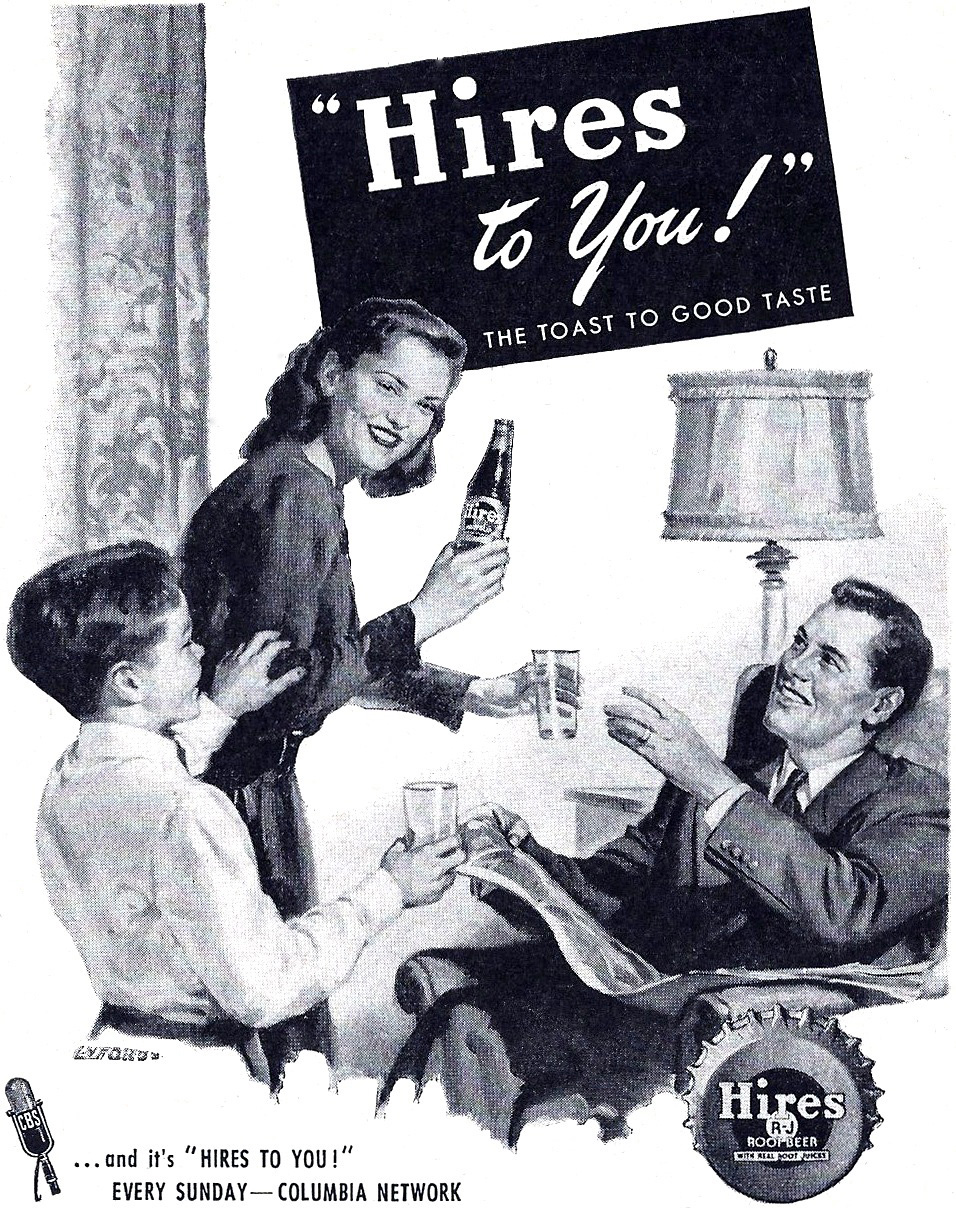
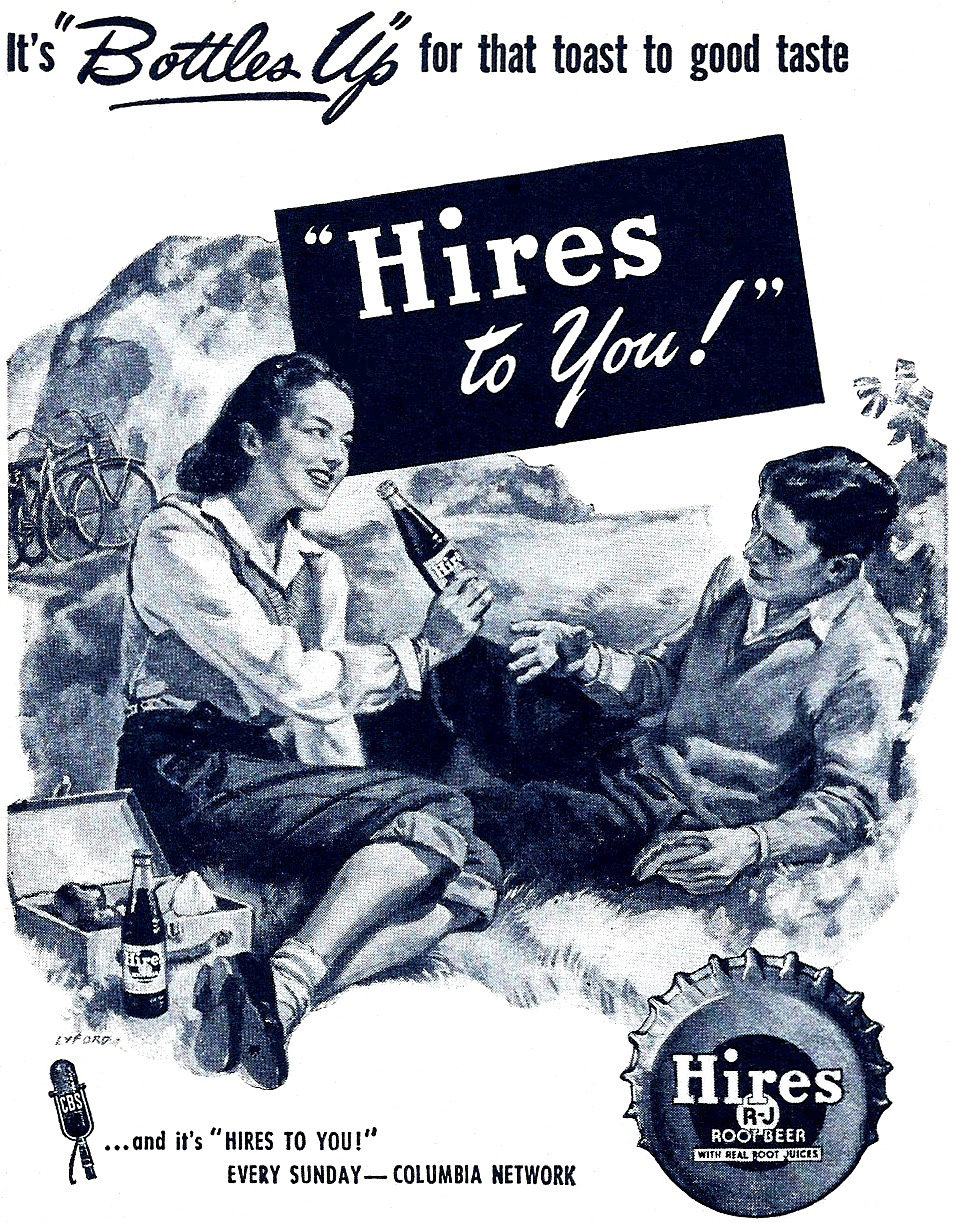
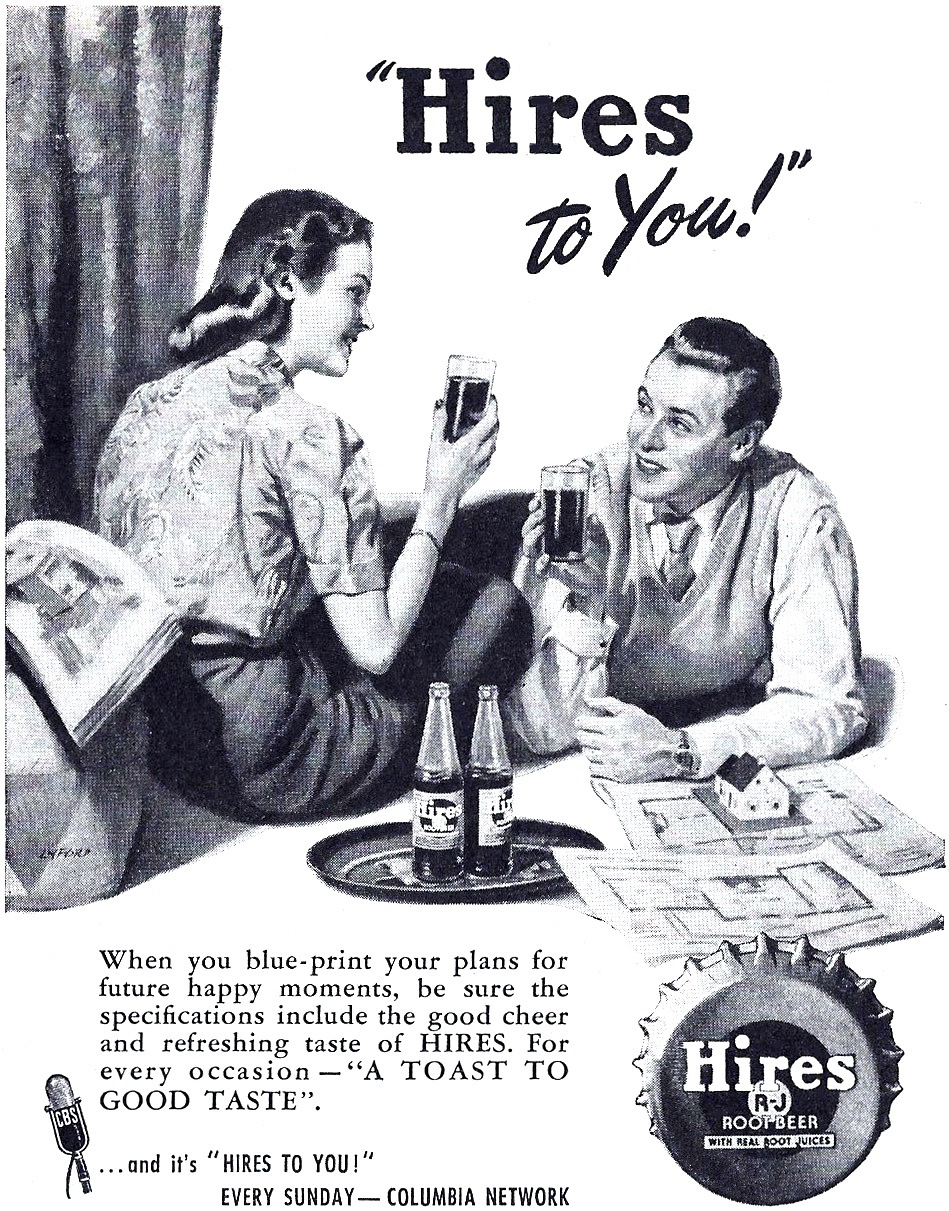

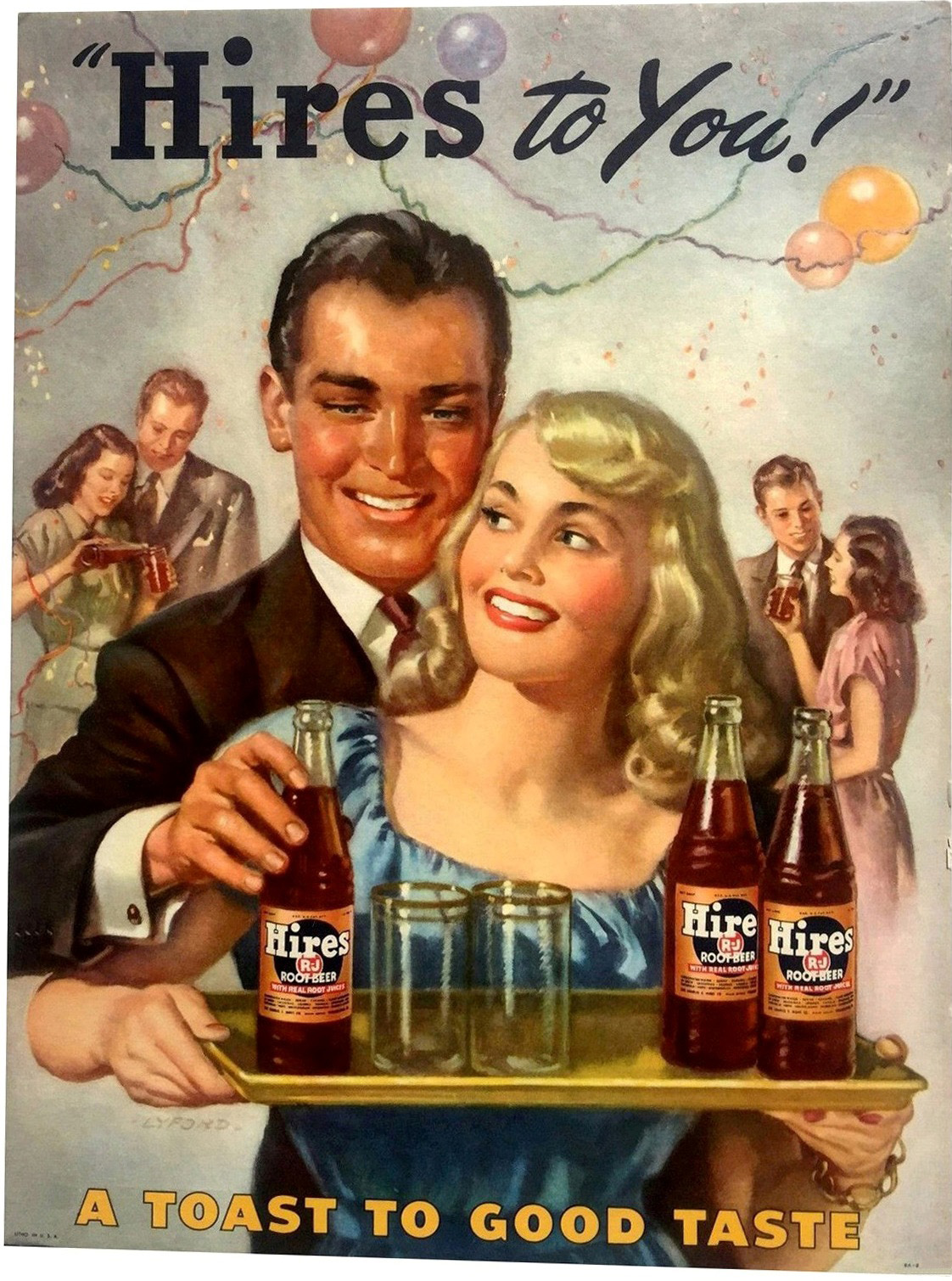
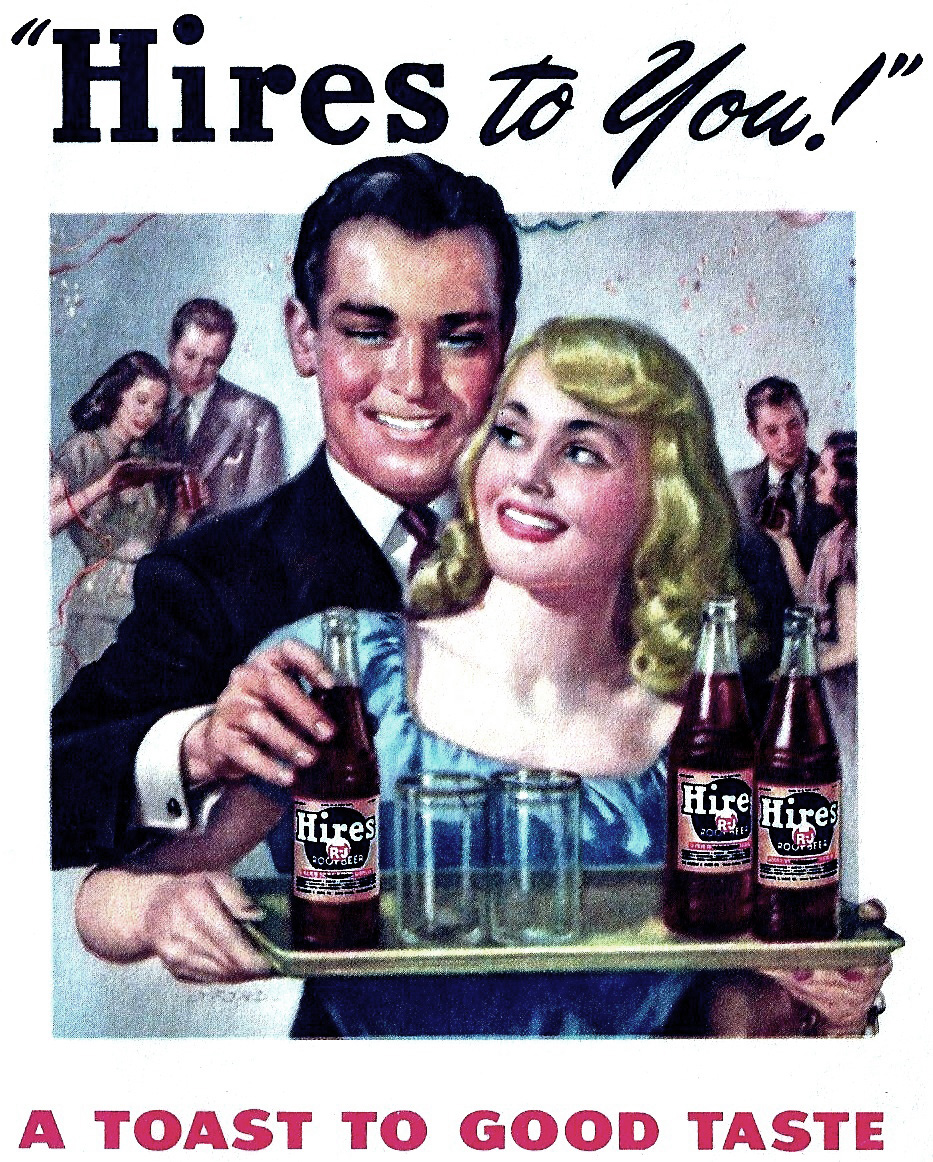

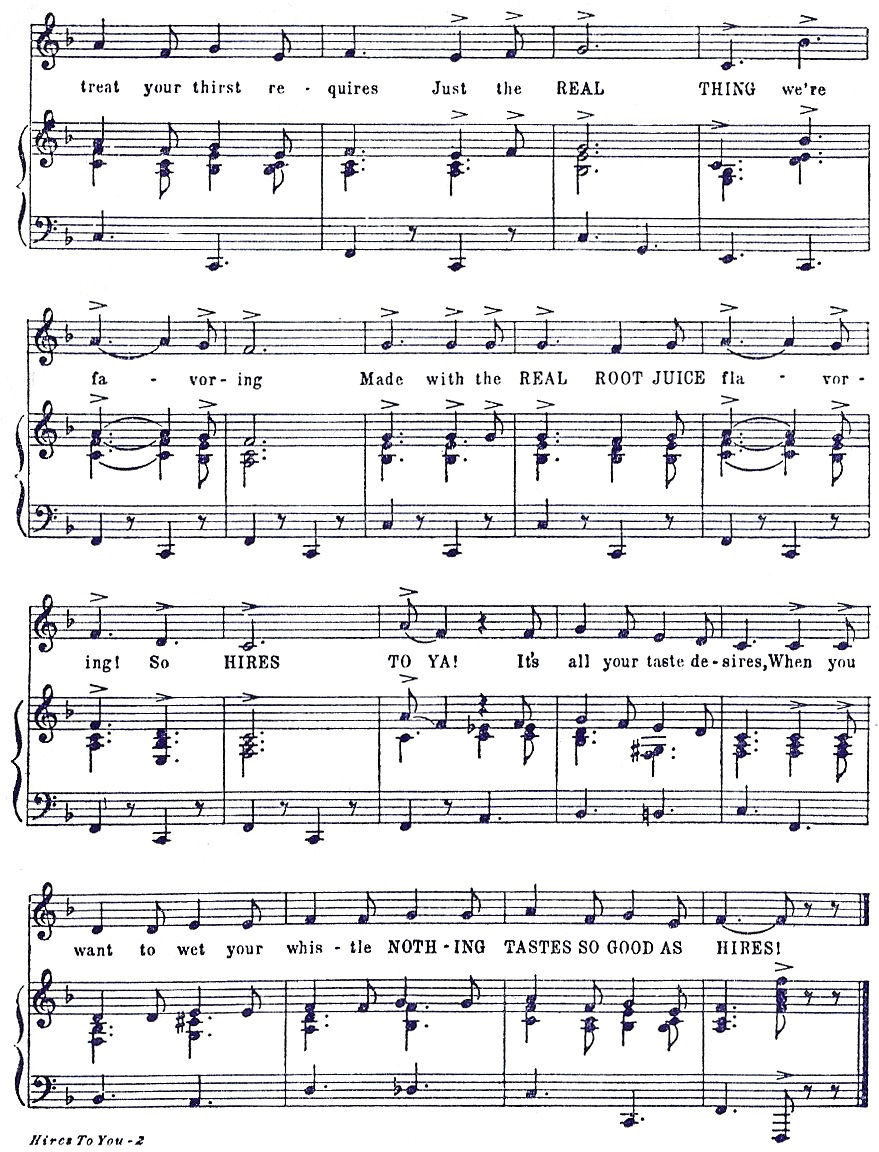
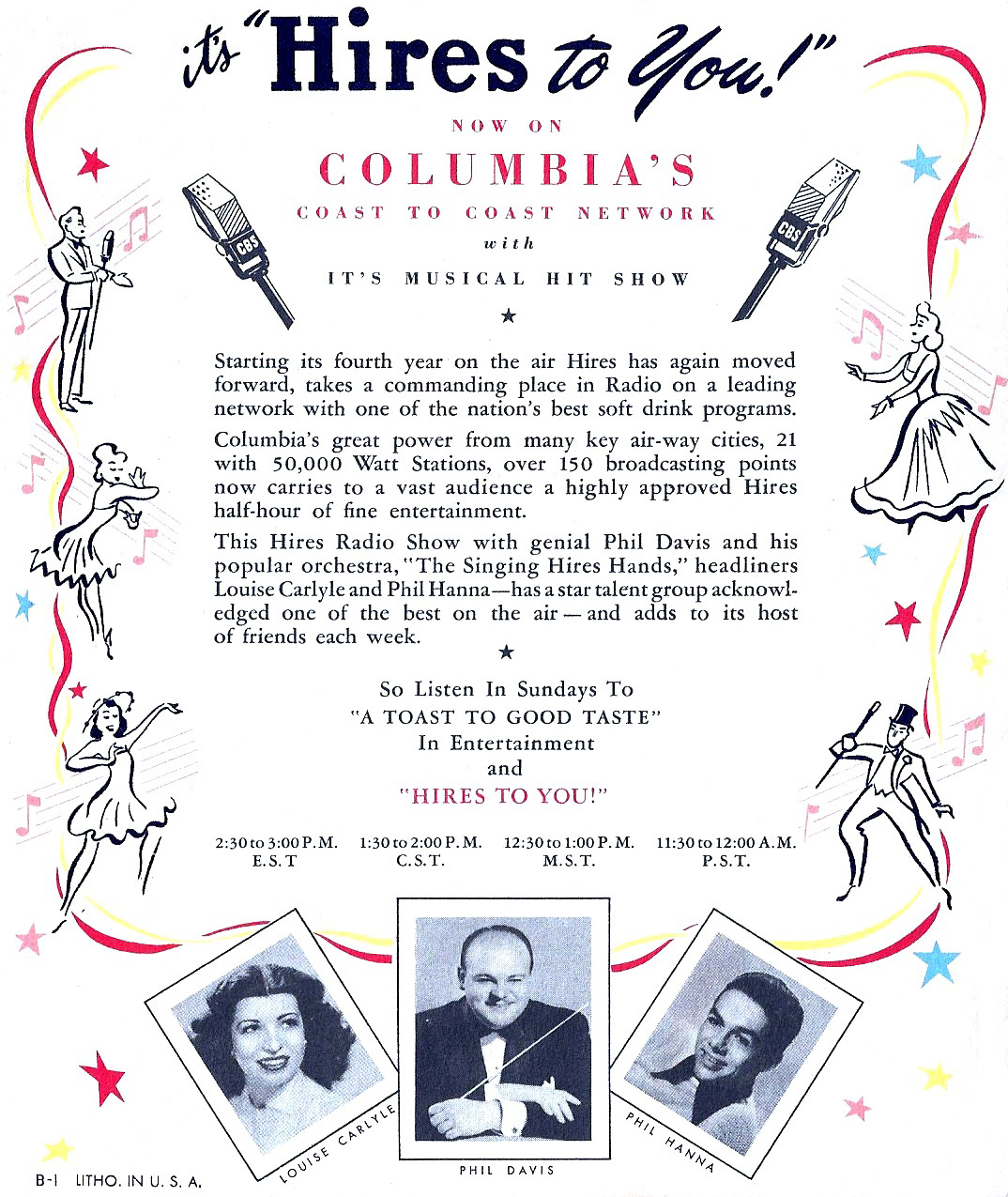

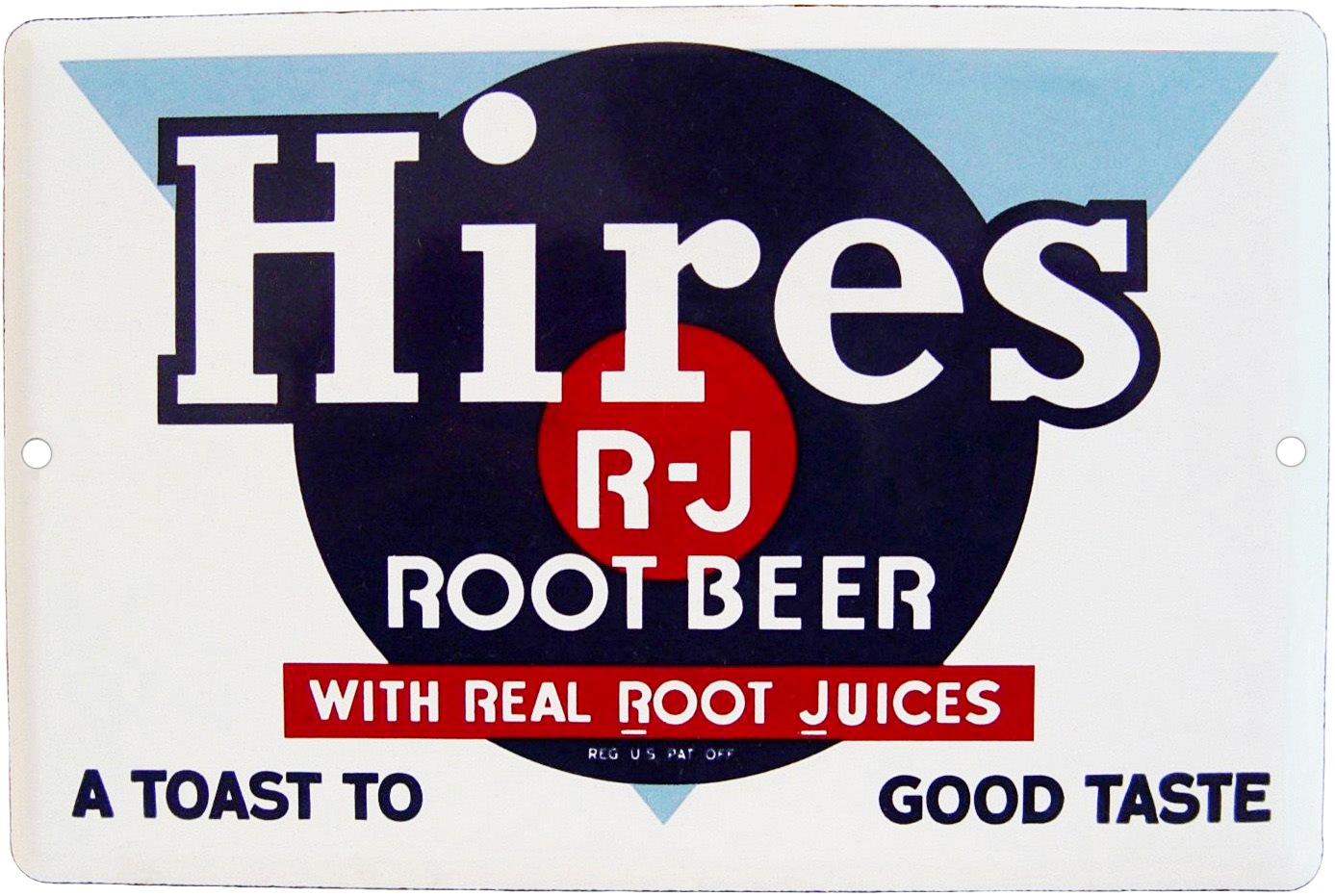
%20Root%20Beer%20With%20Real%20Root%20Juices%20-%20A%20Toast%20To%20Good%20Taste%20-%20embossed%20tin%20sign%2012%20x%2024.jpg)
%20-%20A%20Toast%20To%20Good%20Taste%20-%20porcelain%20sign.jpg)


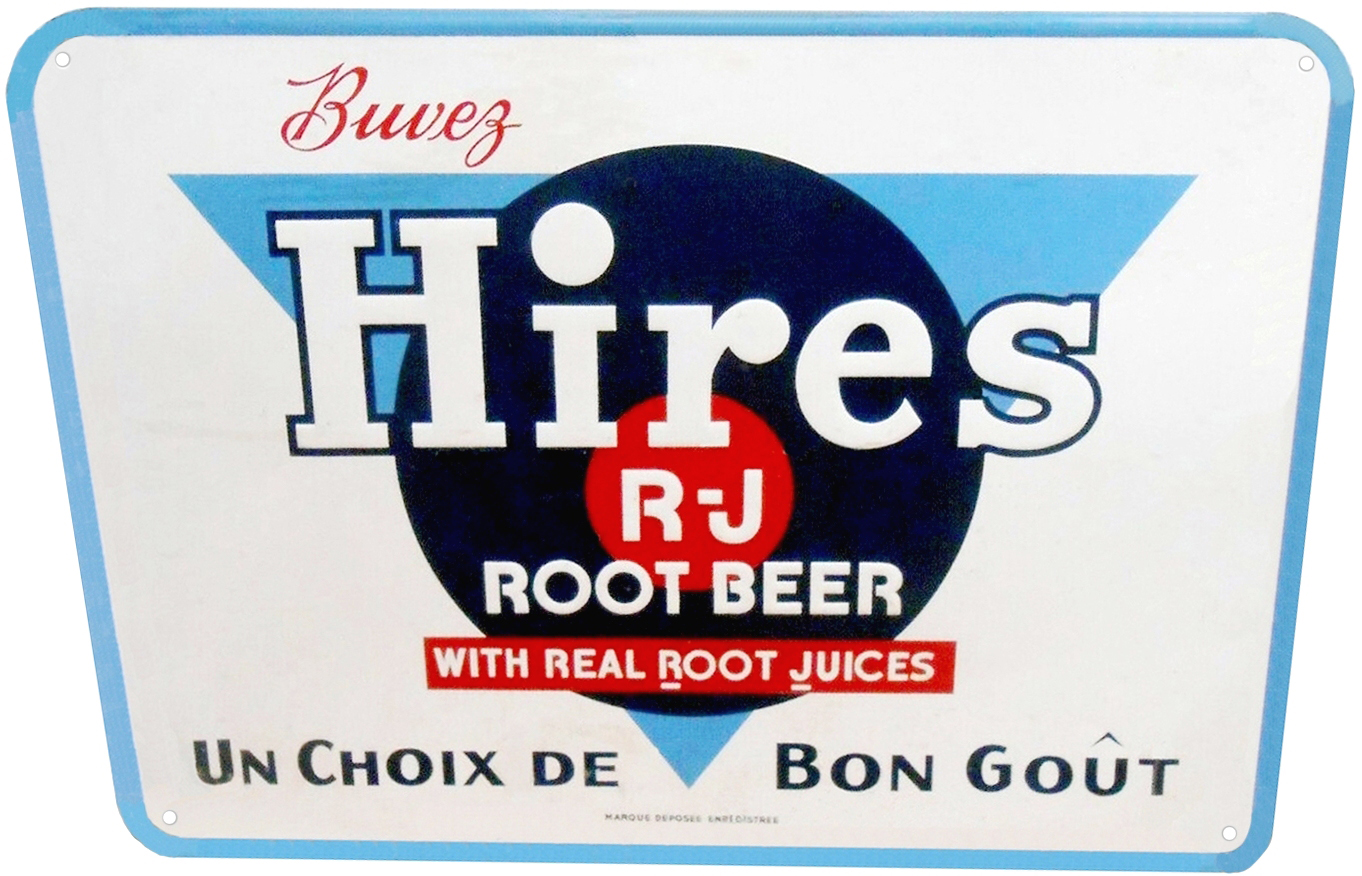
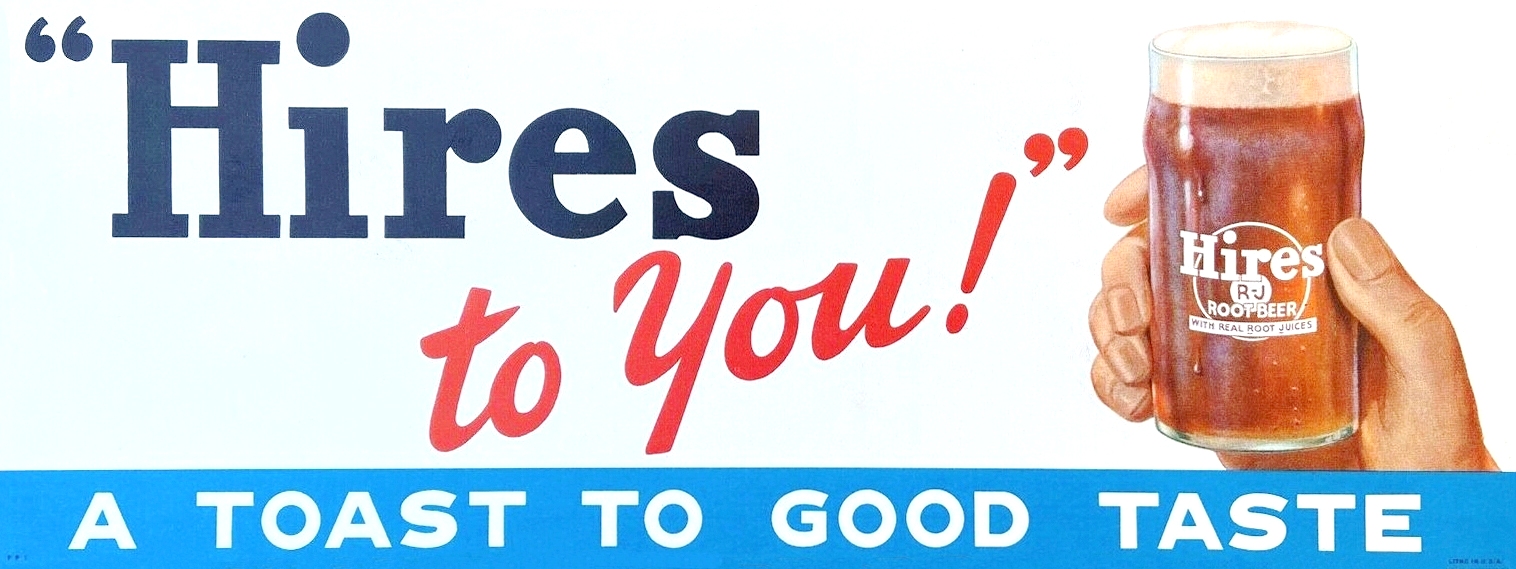
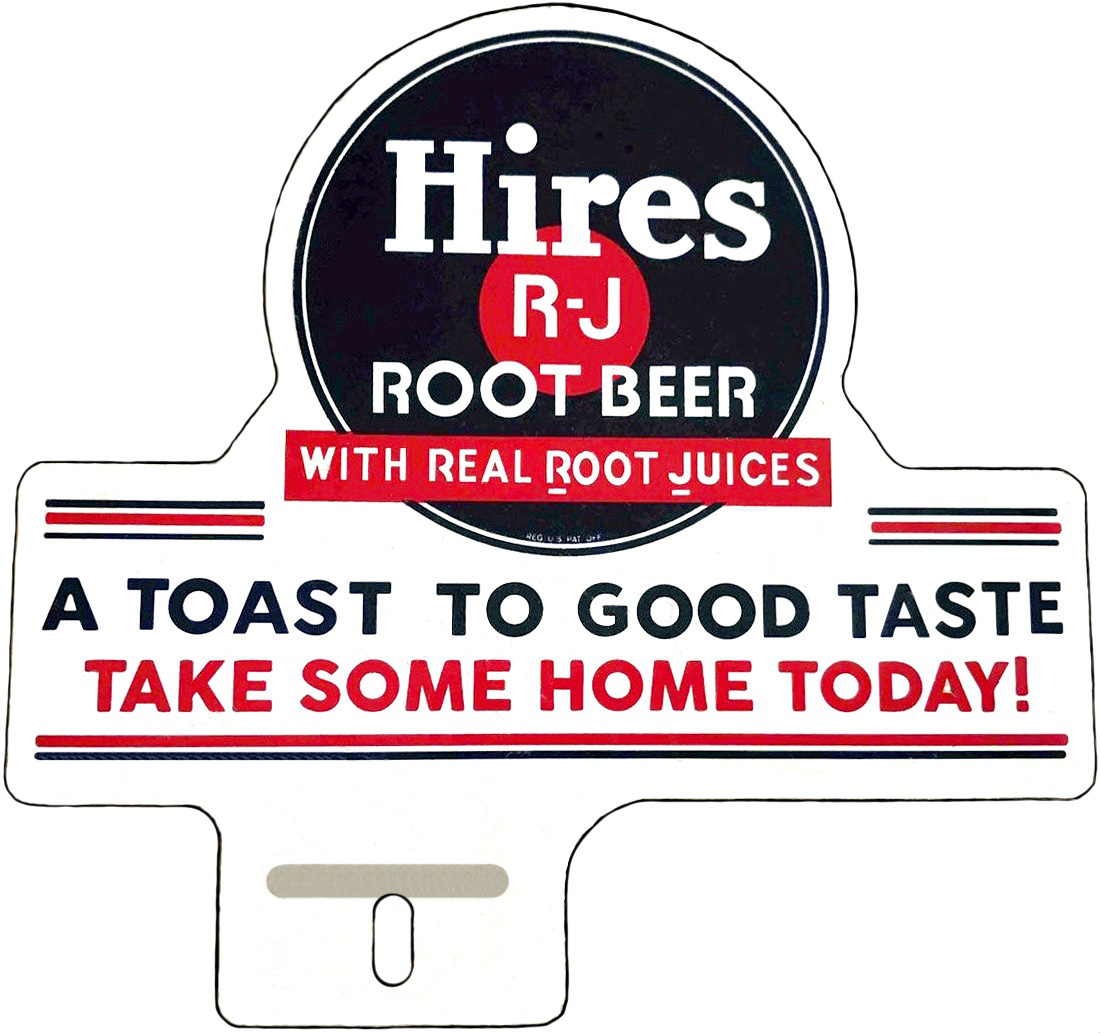
%20Root%20Beer%20With%20Real%20Root%20Juices%20-%20A%20Toast%20To%20Good%20Taste%20Take%20Some%20Home%20Today%20-%20license%20plate%20topper,%20back.jpg)



%20Root%20Beer%20With%20Real%20Root%20Juices%20ACL%20-%20amber%20novelty%20bottle%20-%20front.jpg)
%20Root%20Beer%20With%20Real%20Root%20Juices%20ACL%20-%20amber%20novelty%20bottle%20-%20base.jpg)
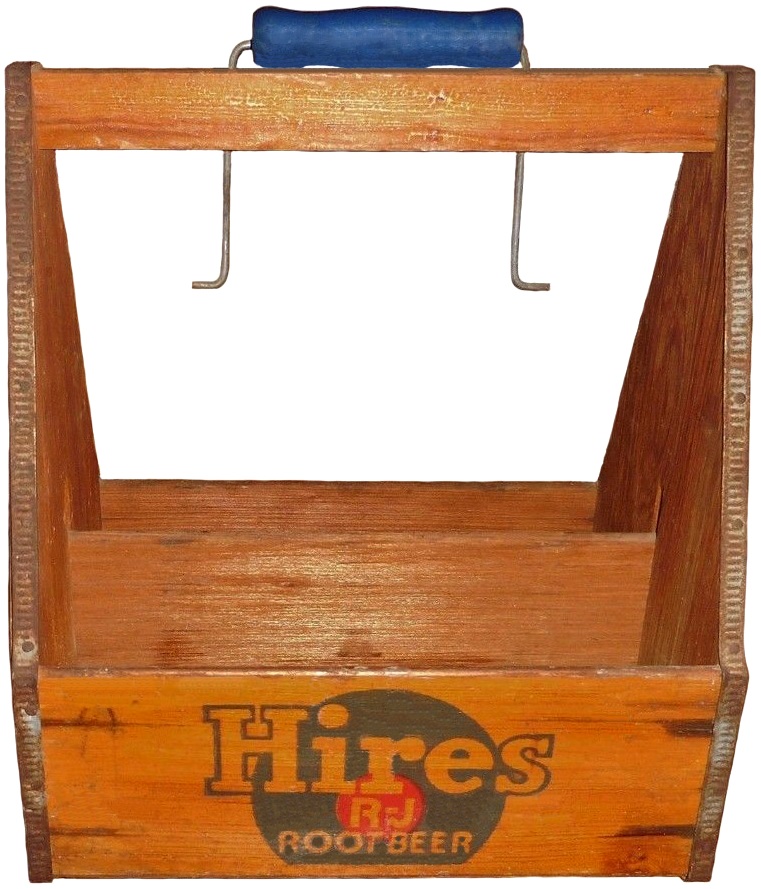
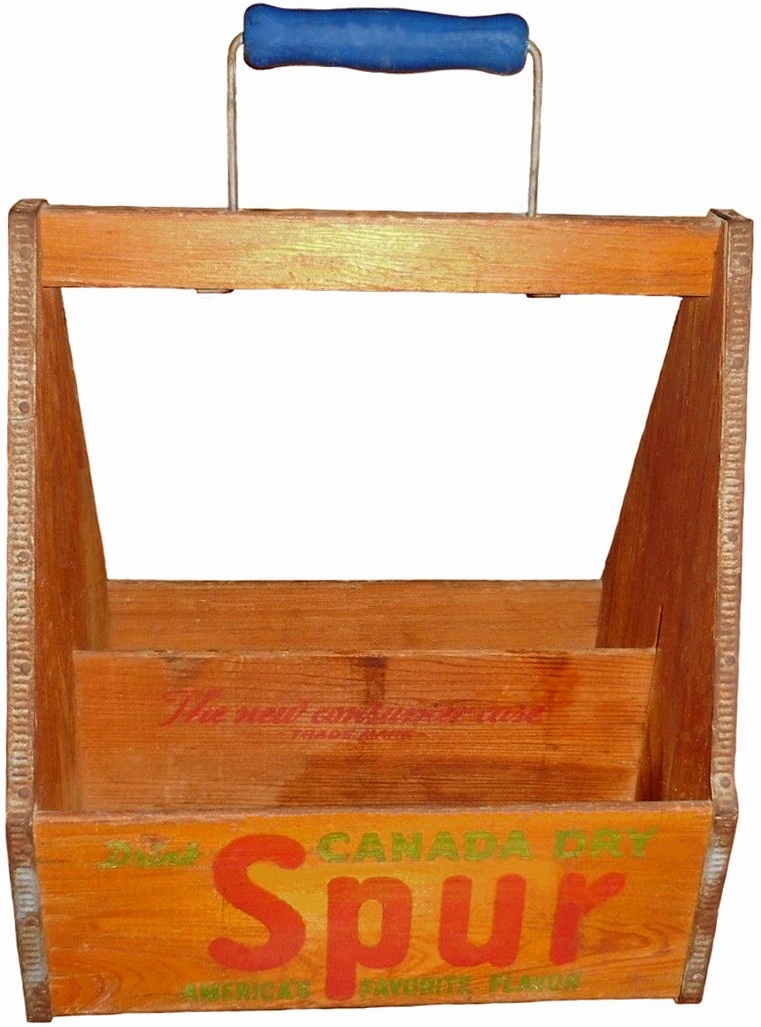
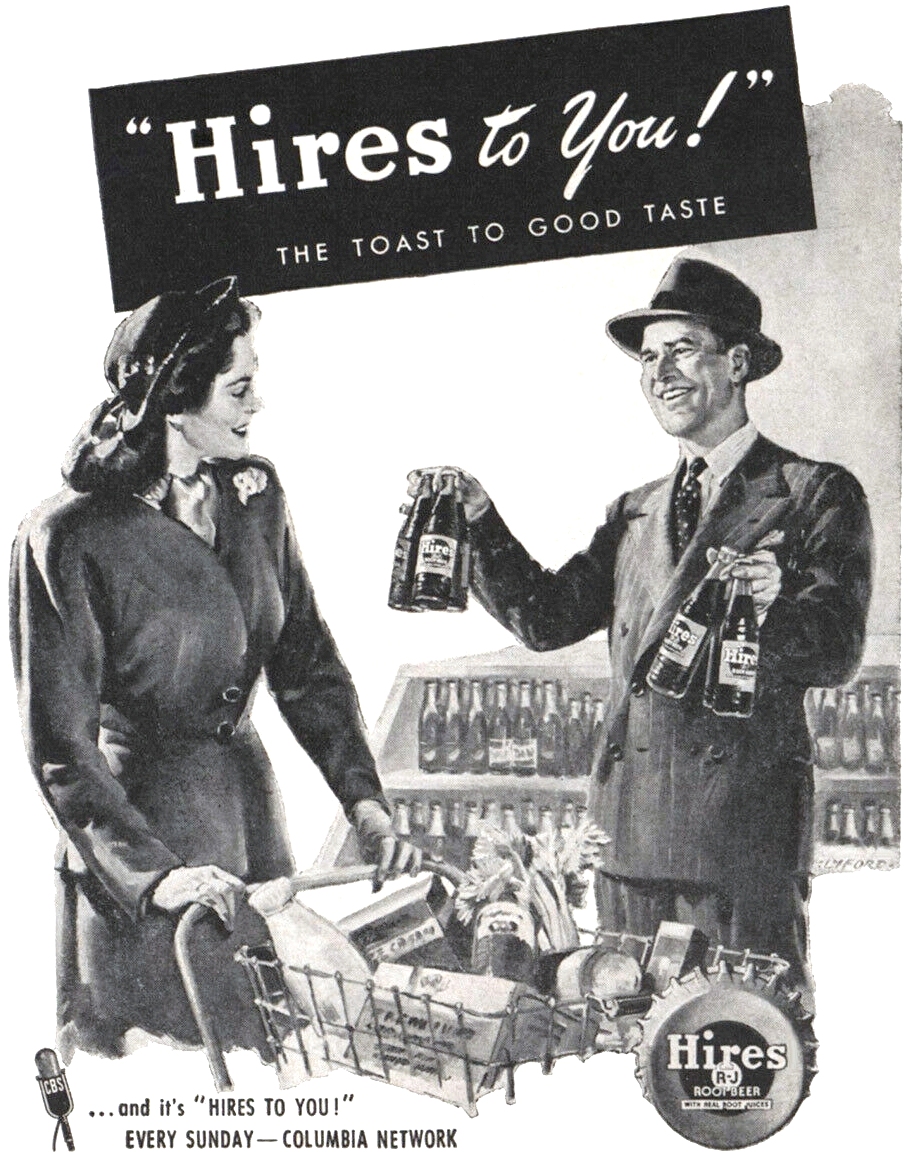
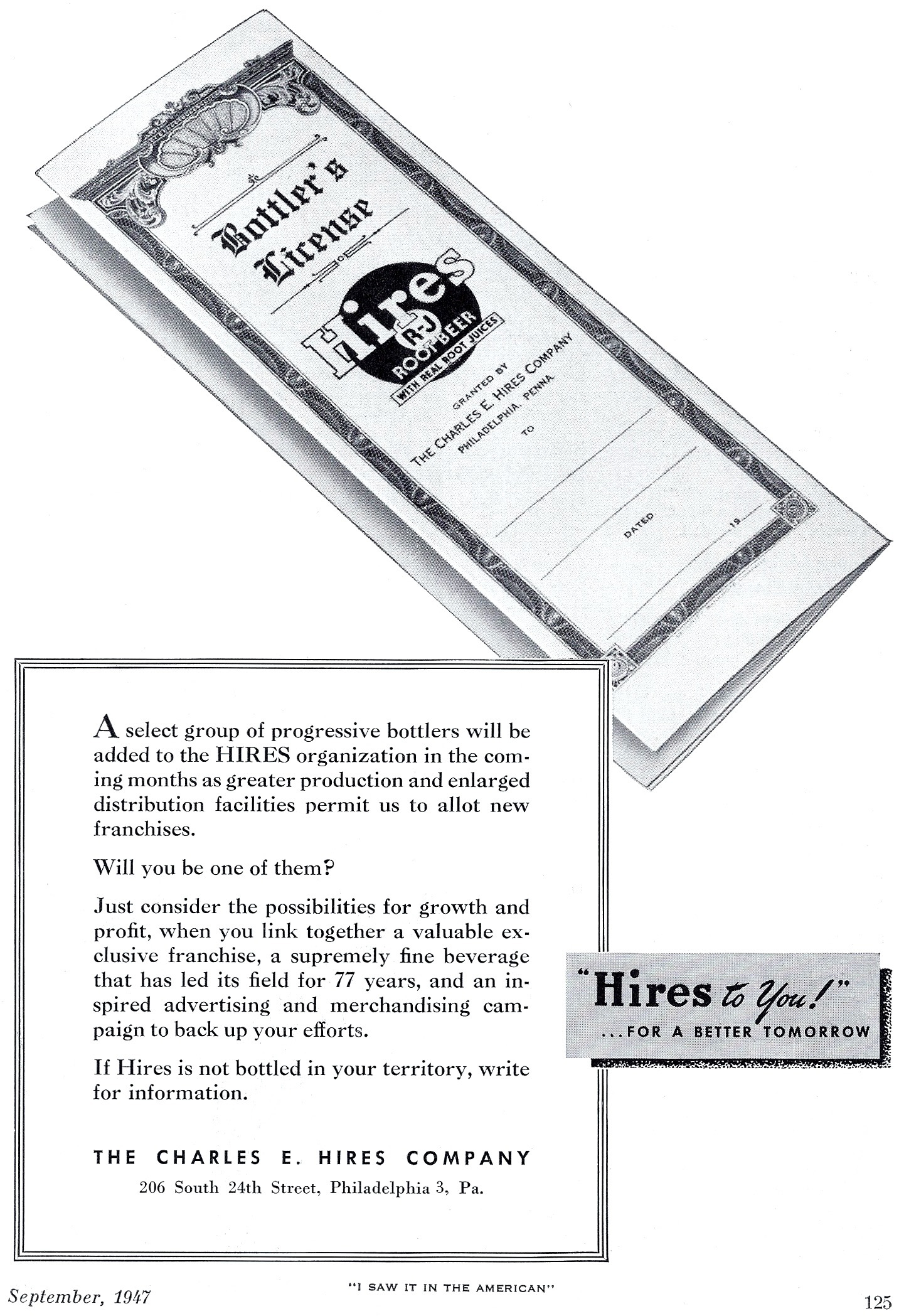
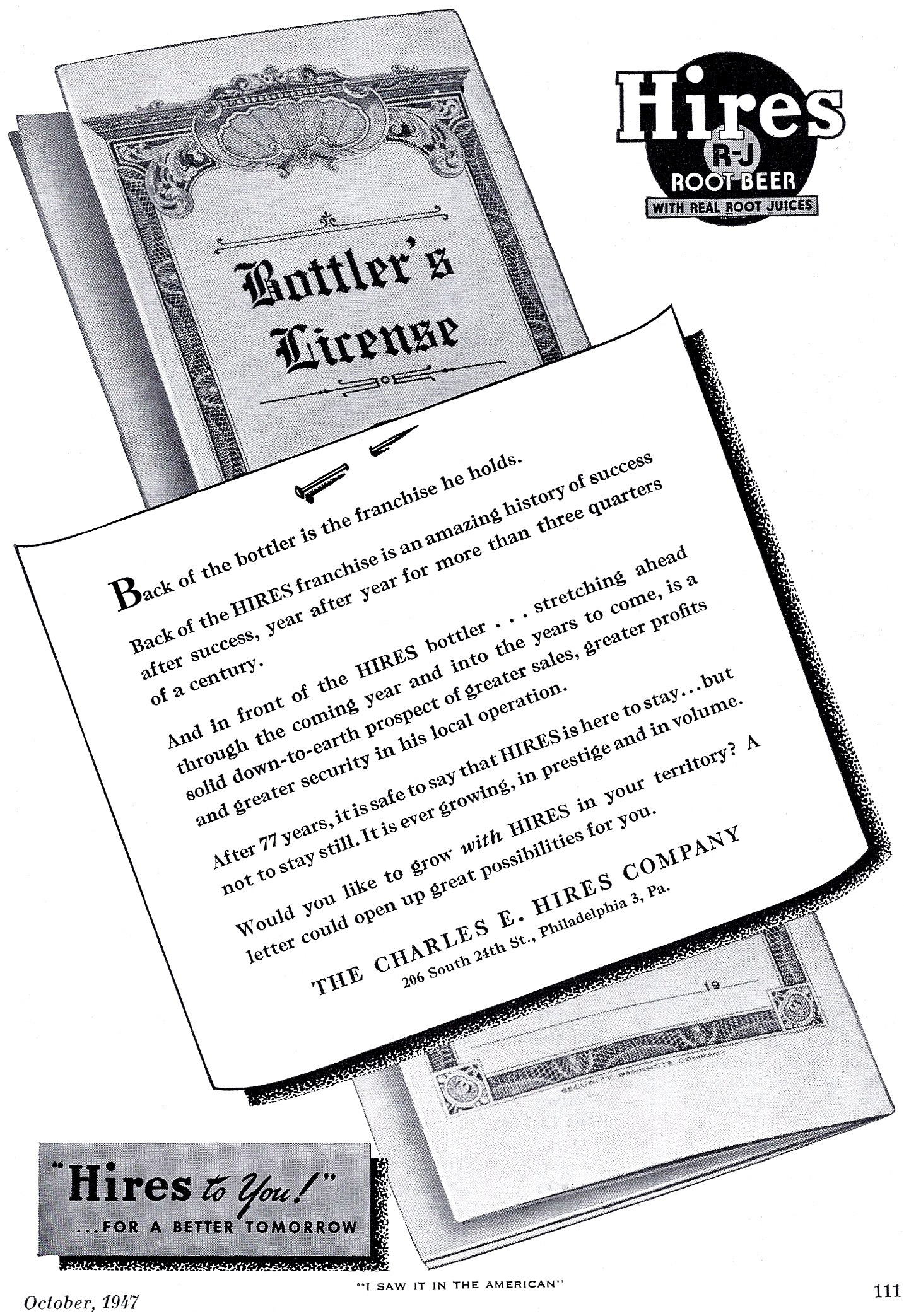
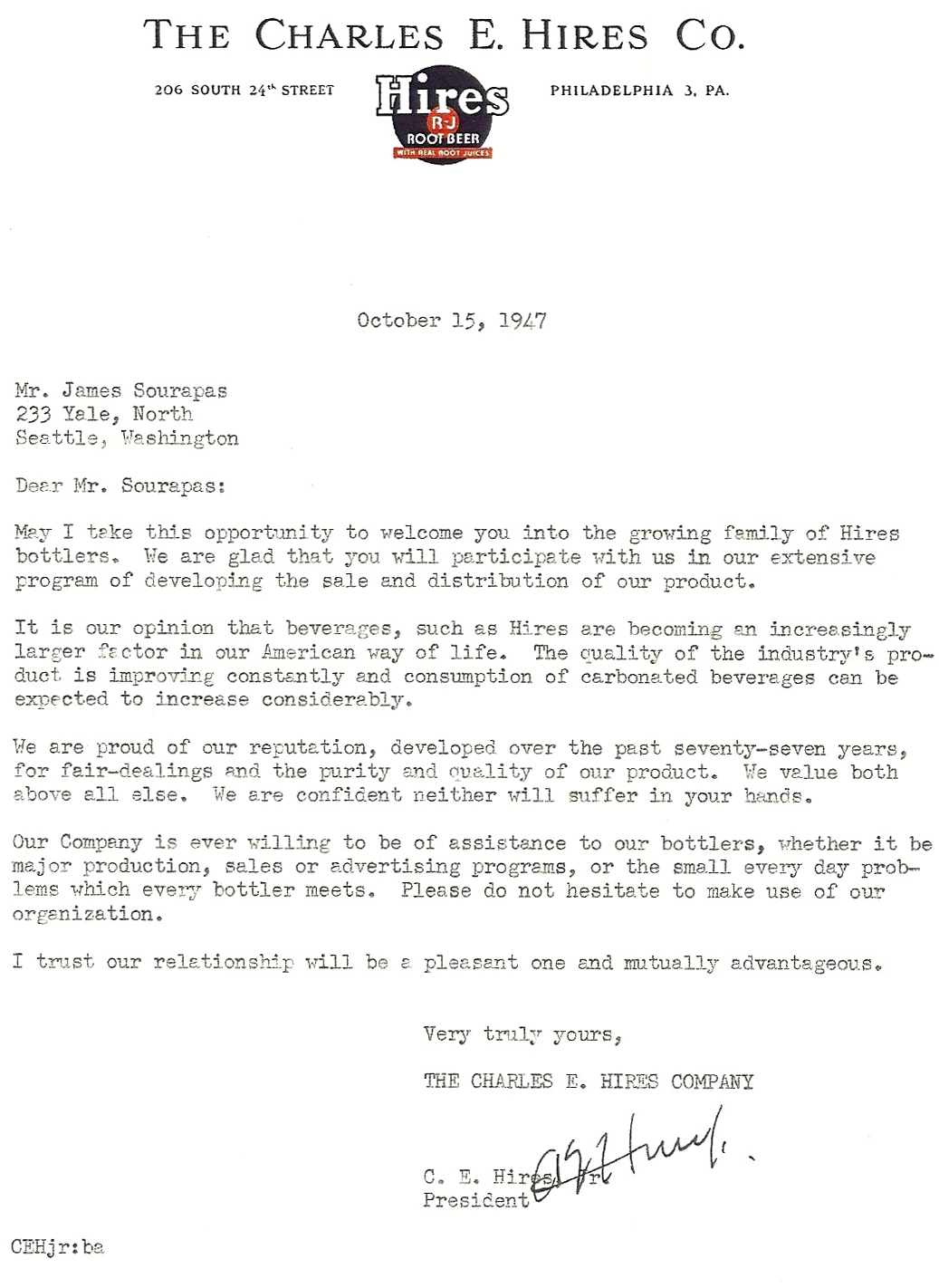
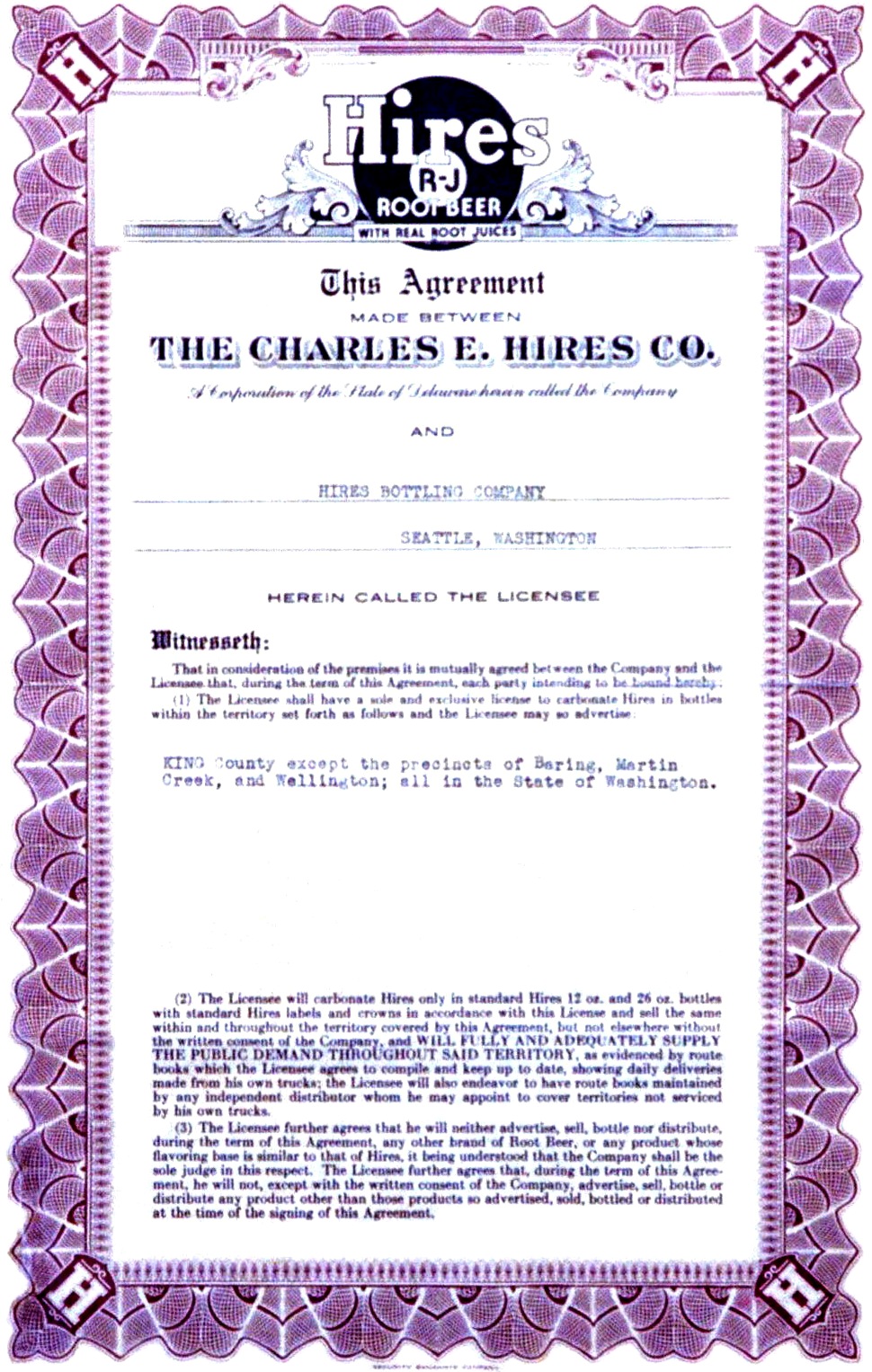
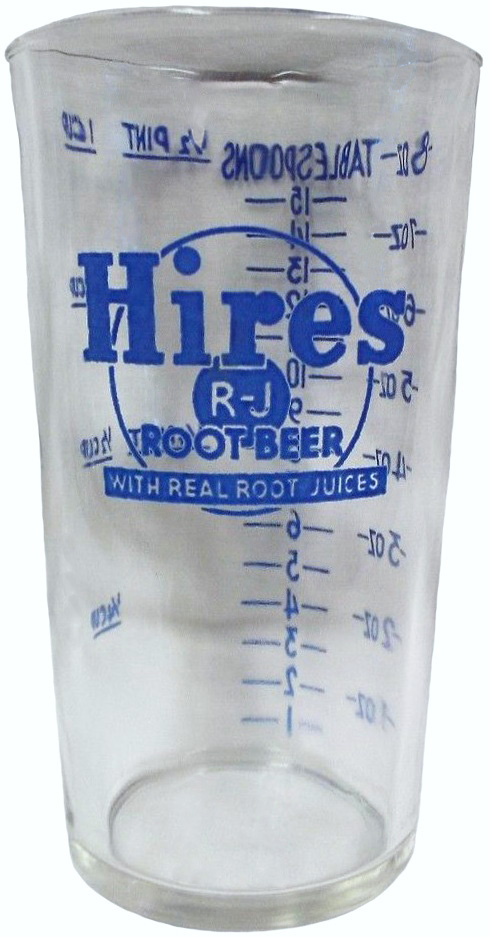

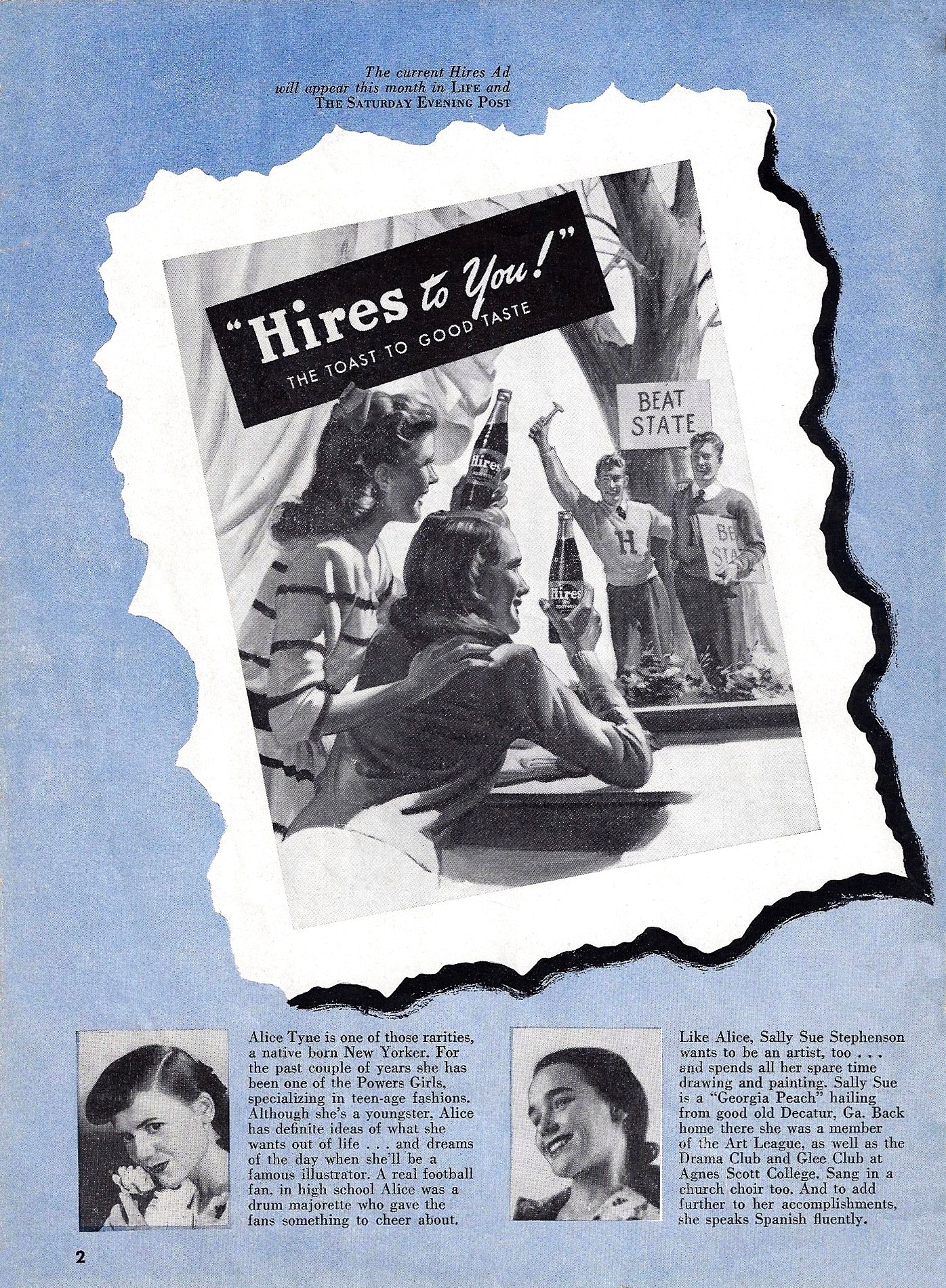
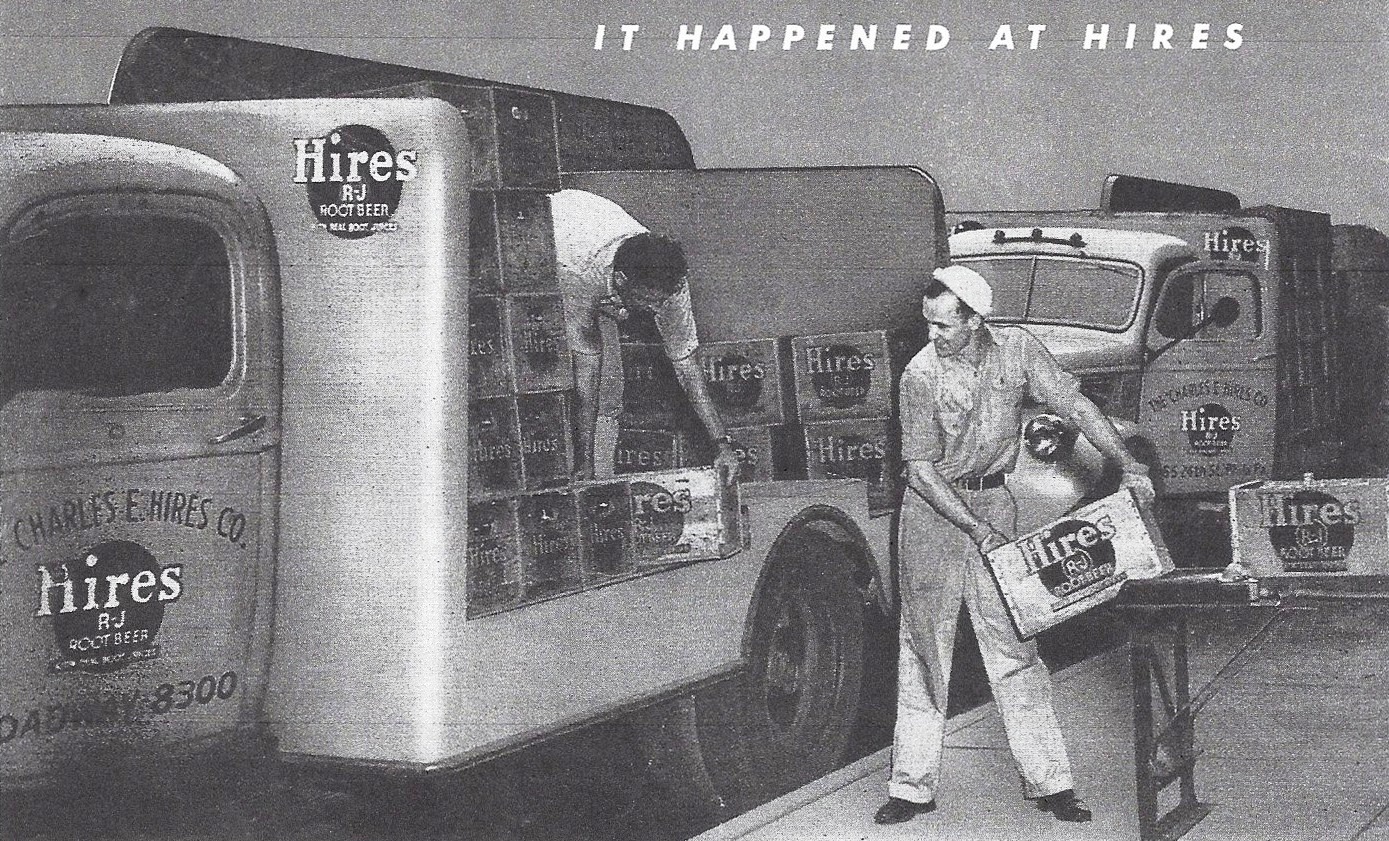
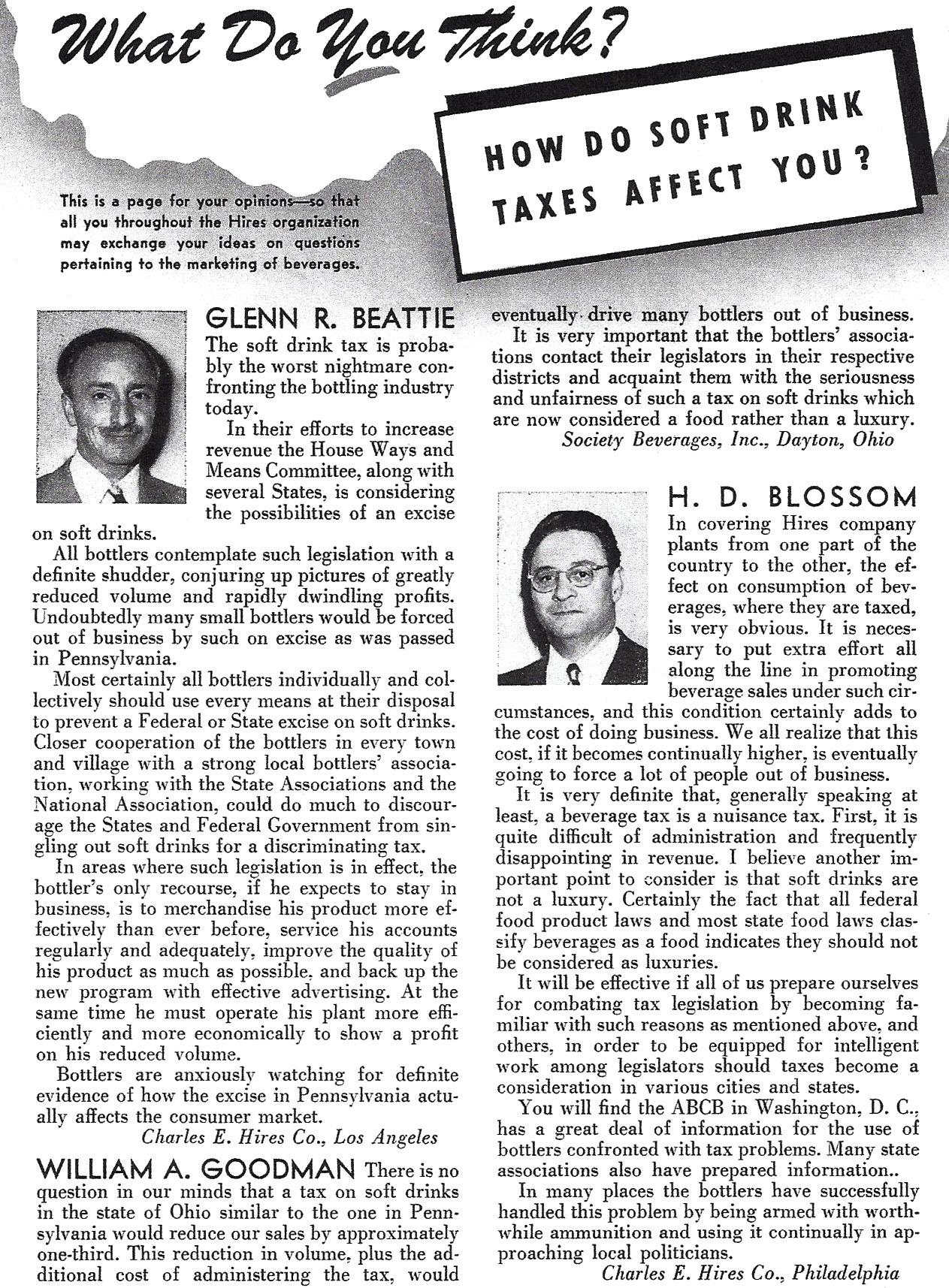
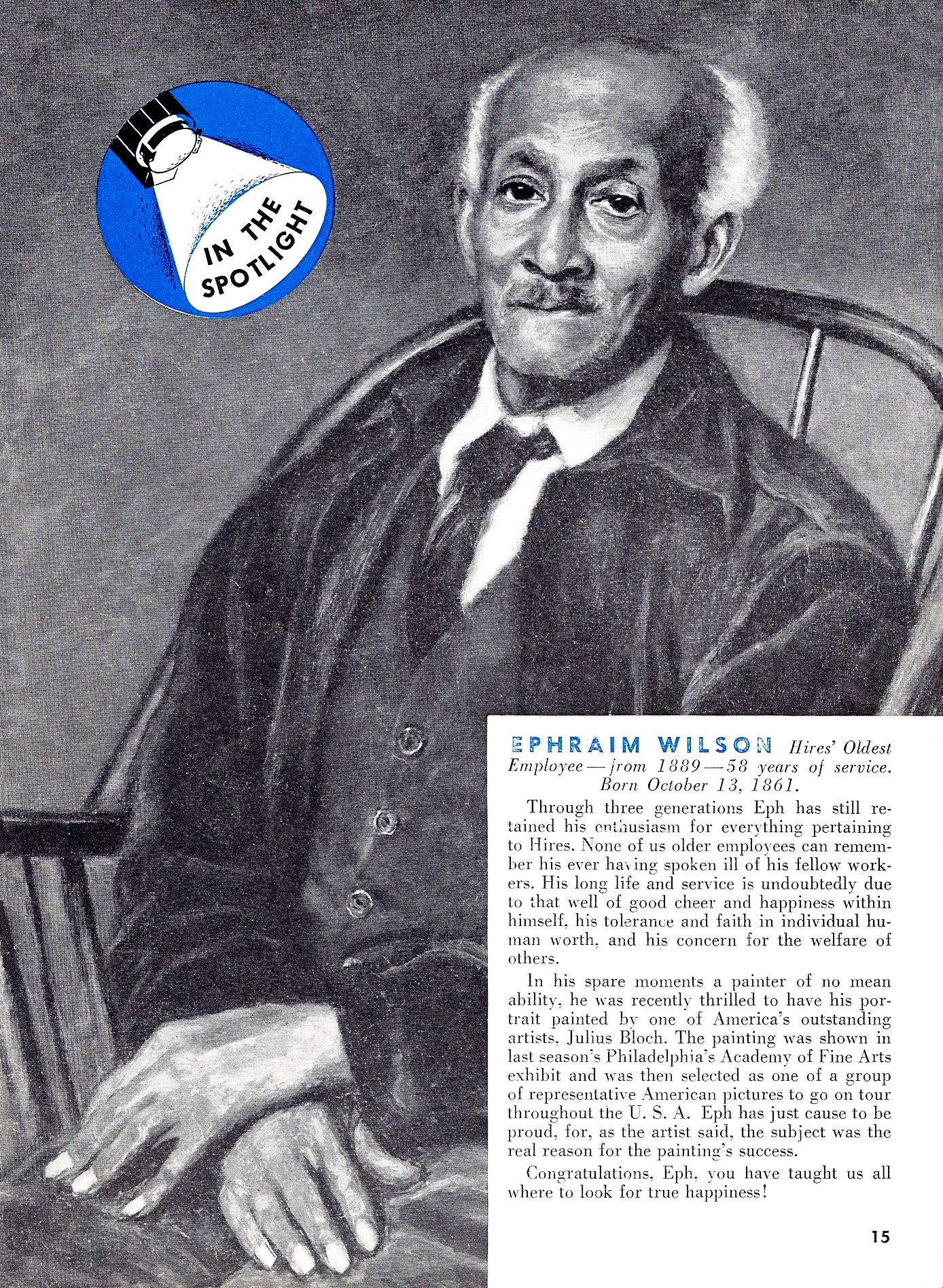
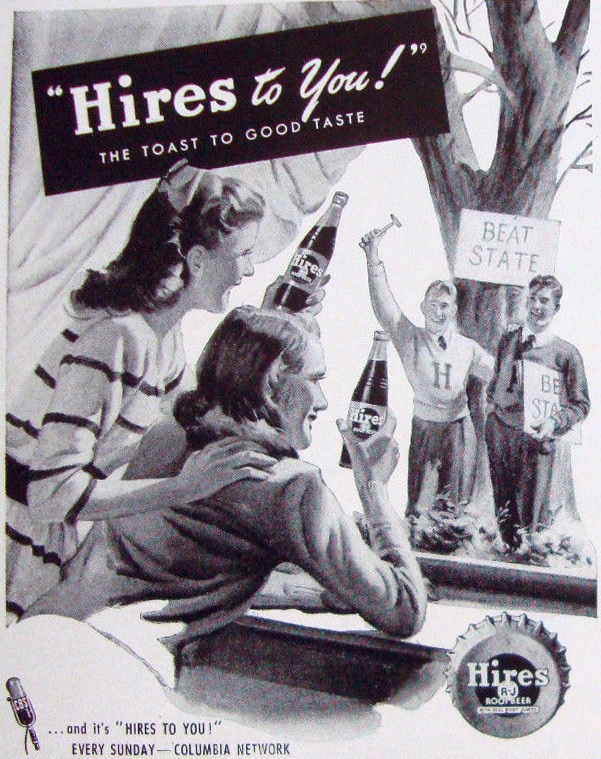
%20wall%20clock.jpg)
%20Root%20Beer%20With%20Real%20Root%20Juices%20Hires%20to%20You%20FOR%20ENJOYMENT%20HERE%20-%20menu%20sheet.jpg)
